Copies
There are over thirty extant paintings based on the Salvator Mundi or on the related Christ the Redeemer. Two of them have recently been dated the late sixteenth century, years after Leonardo’s death. Only three replicate the details in the Hollar engraving: Leonardo’s painting, the so-called Ganay version, and a copy in San Domenico Maggiore in Naples. Both repeat the elaborate knotwork of the stole and have a translucent orb but are in other ways quite different from the original.
Warsaw
The Warsaw painting has often been attributed to Cesare da Sesto. Because it is on oak, it can be dated precisely. Dendrochronology done in 2005 42 established that the tree from which the panel was made was felled in the Seine River Basin around 1586. It cannot therefore have been painted by Cesare da Sesto, who died in 1523. It is likely by a painter working in France in the latter part of the sixteenth century.
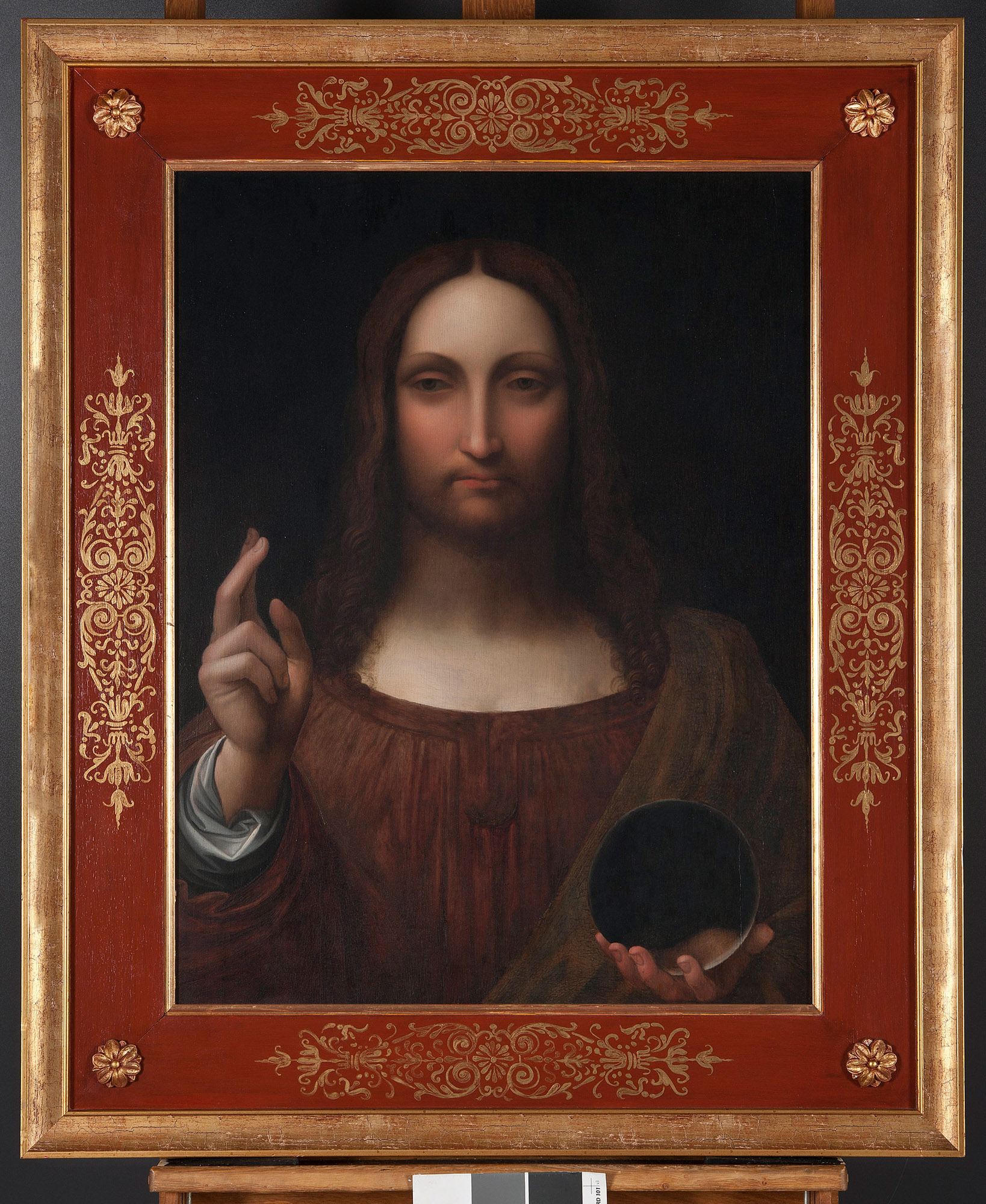
| Follower of Leonardo da Vinci, Salvator Mundi, after 1586 |
| Courtesy of the Museum of King Jan III's Palace at Wilanó |
Detroit
The Detroit version, sometimes attributed to Giampietrino in the past, is also painted on an oak panel composed of three horizontally joined boards. Dendrochronology identified the wood as Baltic oak and dated the felling of the tree to after 1569, 43 excluding its authorship by Giampietrino, who died in 1549.
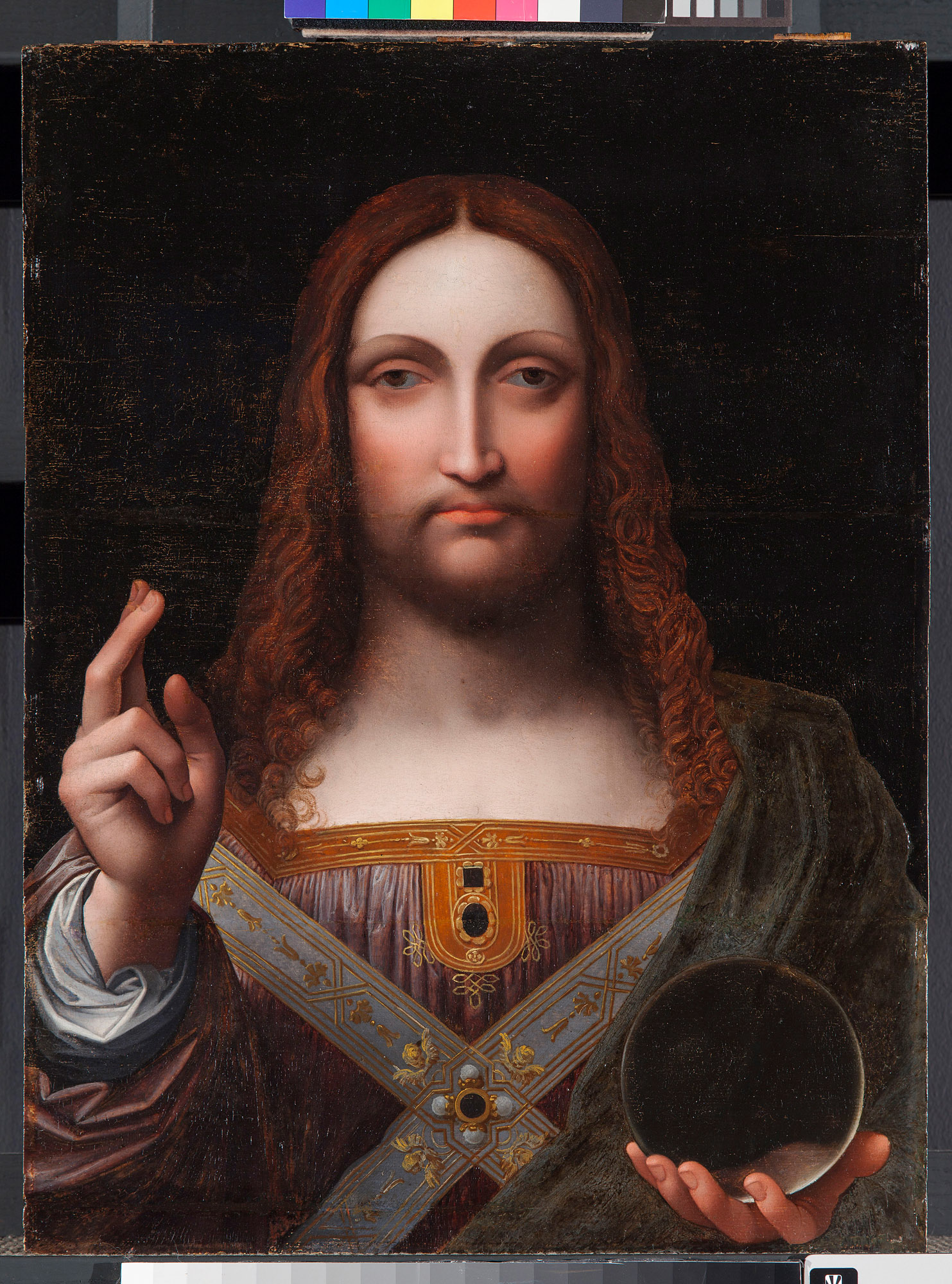
Courtesy of The Detroit Institute of Arts
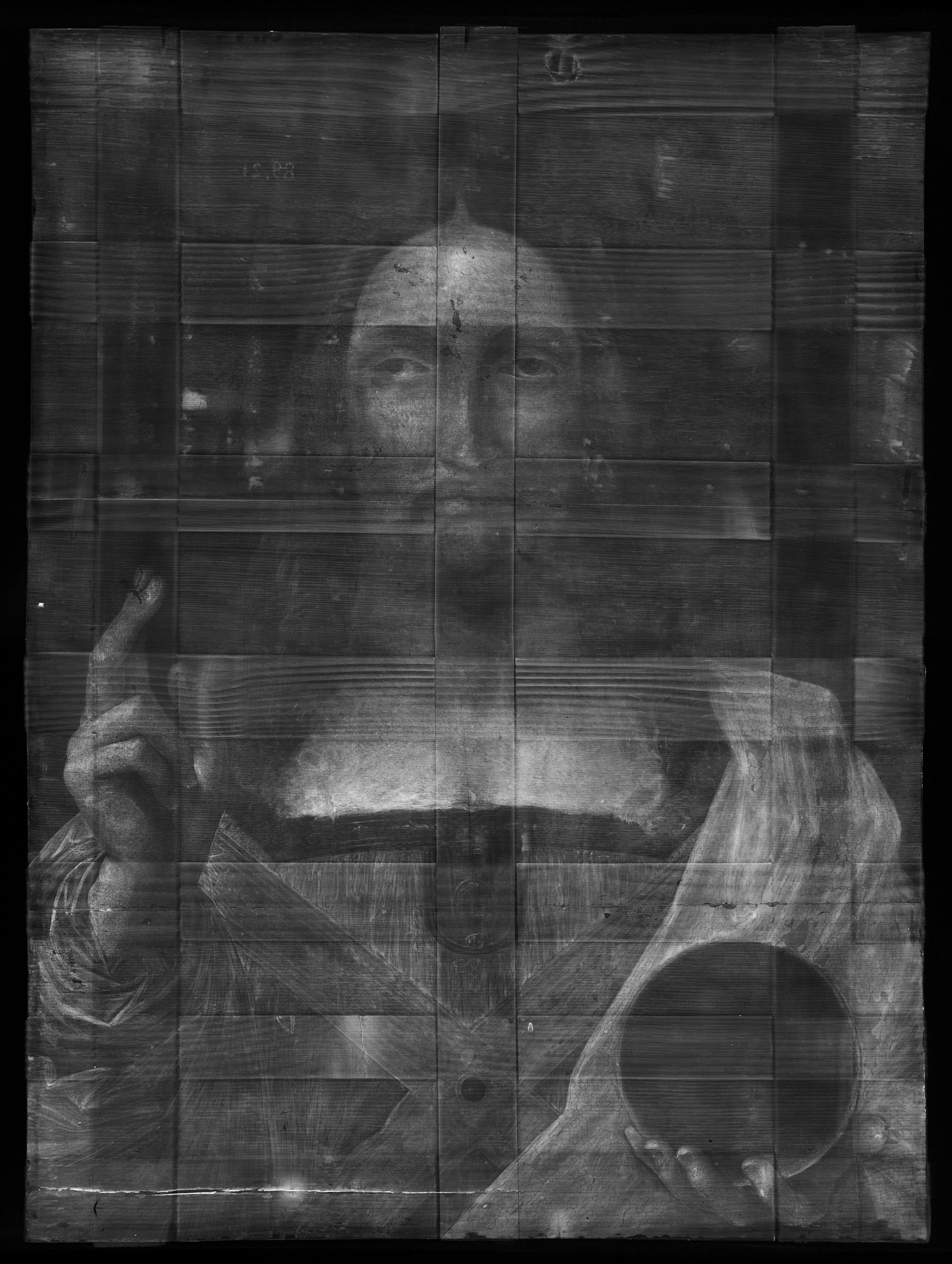
x-radiograph
Ganay
The Ganay version is on a single plank of wood and measures 64 cm x 47 cm. No image of the reverse of the panel is available, but no cradle or any other marks on the reverse appear in the x-radiograph. In 1978 it was attributed to Leonardo by Joanne Snow-Smith. 44 It had been acquired by the Comtesse de Behague in 1902 from the Baron de Lareinty. According to the heirs of the Comtesse, before the Baron purchased the painting it was in a convent in Nantes. Snow-Smith suggested that it had been donated to this convent by Louis XII following the death of his wife, Anne of Brittany, in 1514 and remained there until its purchase by Baron de Lareinty. 45 If this is correct, it would have been in France since the early sixteenth century.
The panel is said to be walnut based on information supplied to Snow-Smith by Madeleine Hours of the Louvre in 1976 and is presumed to be accurate although the method of identifying the wood species is not described. 46 The lead white in the preparation is so dense in comparison to the paint layers that in the x-radiograph the image is invisible. In the infrared scans, some spolvero and distinct, rather schematic underdrawn lines are visible in most passages, indicating that the design was transferred from a cartoon. The dots of spolvero are most apparent in the pleats along the neck band and are relatively widely spaced.
The painting was cleaned in 1976 in Paris by Mme. Sylvaine Brans, whose report stated that the background is repainted and was originally blue; there was once a gold halo; and the blue drapery over the proper left shoulder is a somewhat later addition. 47 (It seems to me, that although beneath the orb, red drapery is visible, the blue is contemporary with the rest of the painting and was simply painted up around the contours of the orb and hand after the red gown had been laid in. It appears to be lapis.) A cross had once been painted over the orb, scraped off but still partly visible, presumably part of the later reworking. The distinct, full beard was not questioned by the restorer and appears to be original. The folds of the red drapery include the omega sign seen in the Windsor drawing. When superimposed over the original, the compositions as a whole do not line up, although all of the individual elements do when the images are shifted, with the exception of the curls, which are a free interpretation of Leonardo’s carefully constructed whorls and helixes.
The drapery folds of the proper left shoulder are very similar to those in the Hollar etching. The underdrawing confirms that this is not due to an alteration of the lapis pigment, which affects this passage in the original, but that the design was conceived from the beginning. If indeed the folds of this passage in Leonardo’s painting resembled their appearance in the cleaned state, without numerous pleats, this would suggest that the Ganay version was painted after the alteration of the ultramarine pigment took place and is therefore somewhat later.
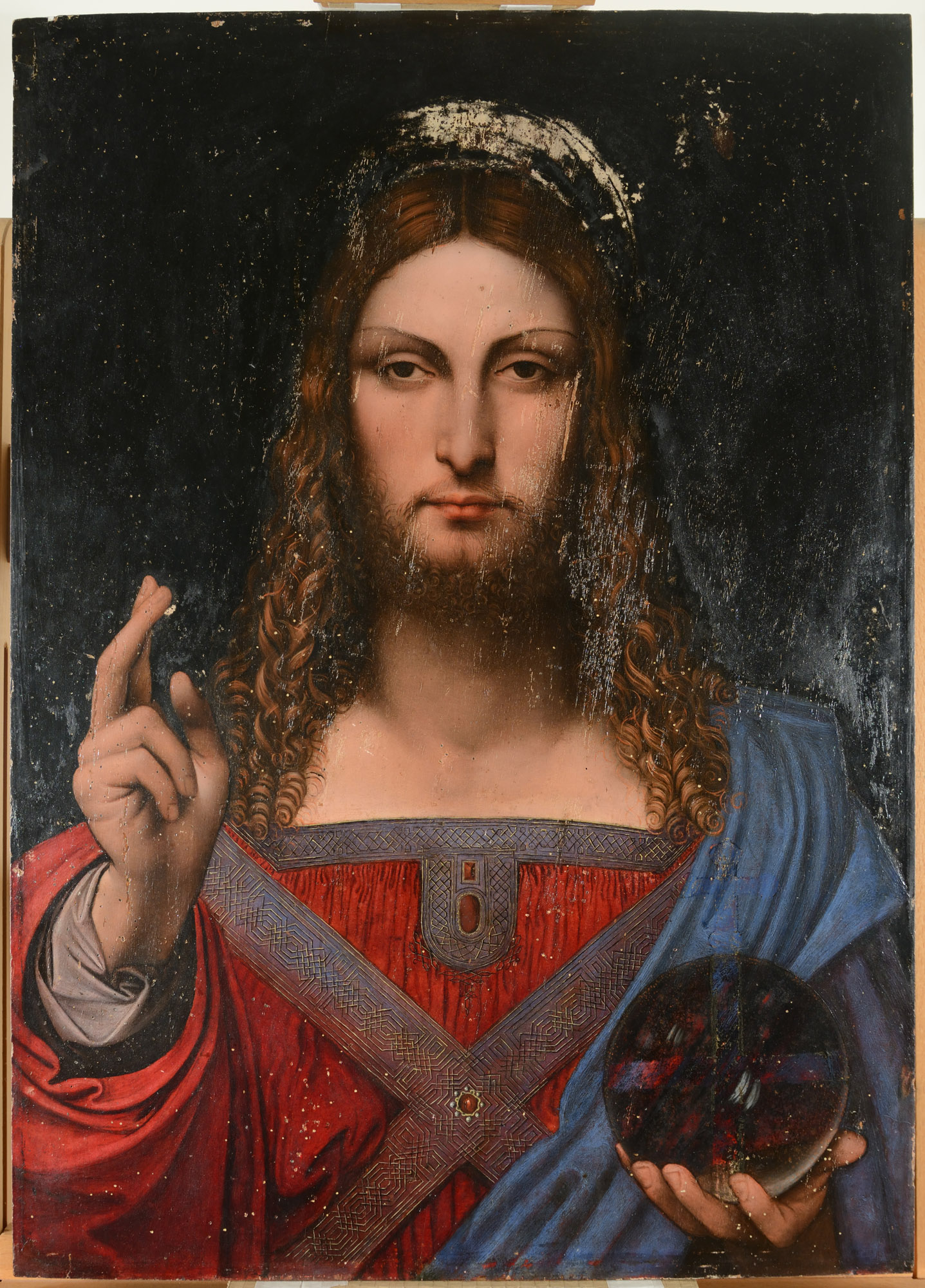
Private Collection
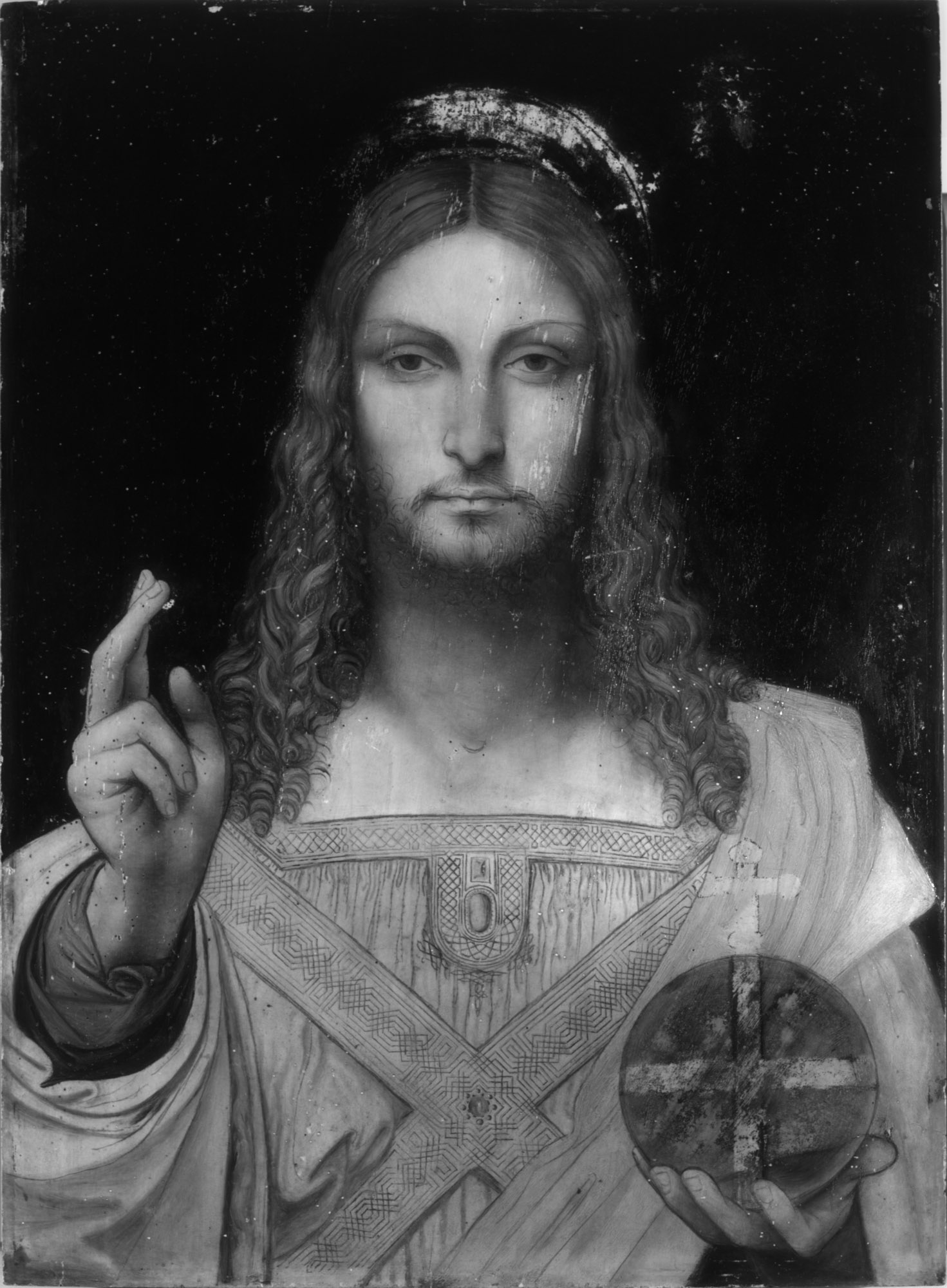
Infrared scan
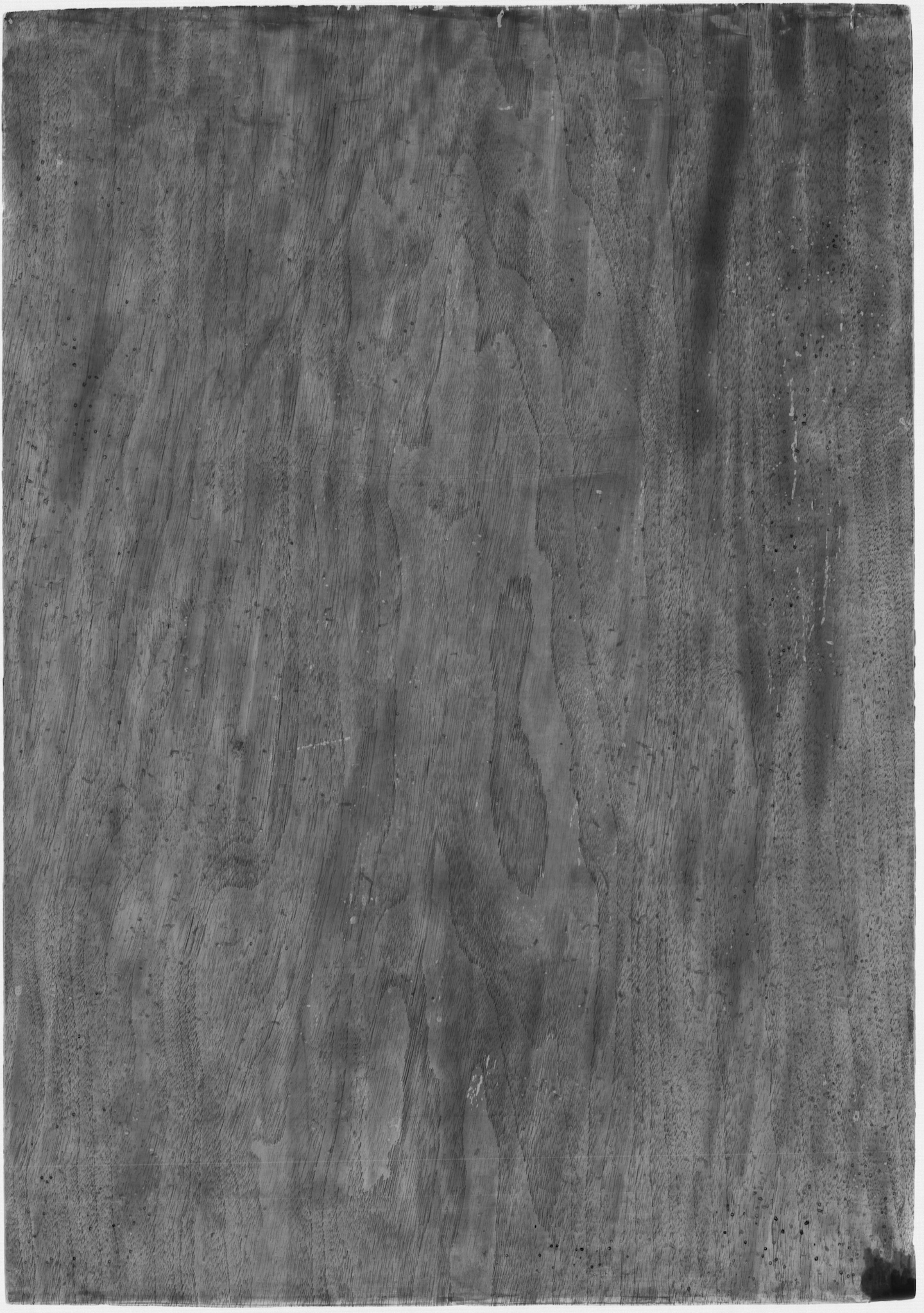
X radiograph
Naples
The Naples version is painted on a single plank of walnut, which measures 66.5 x 46.5 cm. The edges are covered by a frame so it wasn’t possible to ascertain if there is a reserve of wood along the borders.
The painting was the subject of a technical study by Emmebi Diagnostica Artistica, Rome carried out on site in May, 2019. The images and analytical information included here are excerpted from their partial report. The wood was identified by microscopic examination of the cellular structure.

San Domenico Maggiore, Naples
 Infrared scan
Infrared scan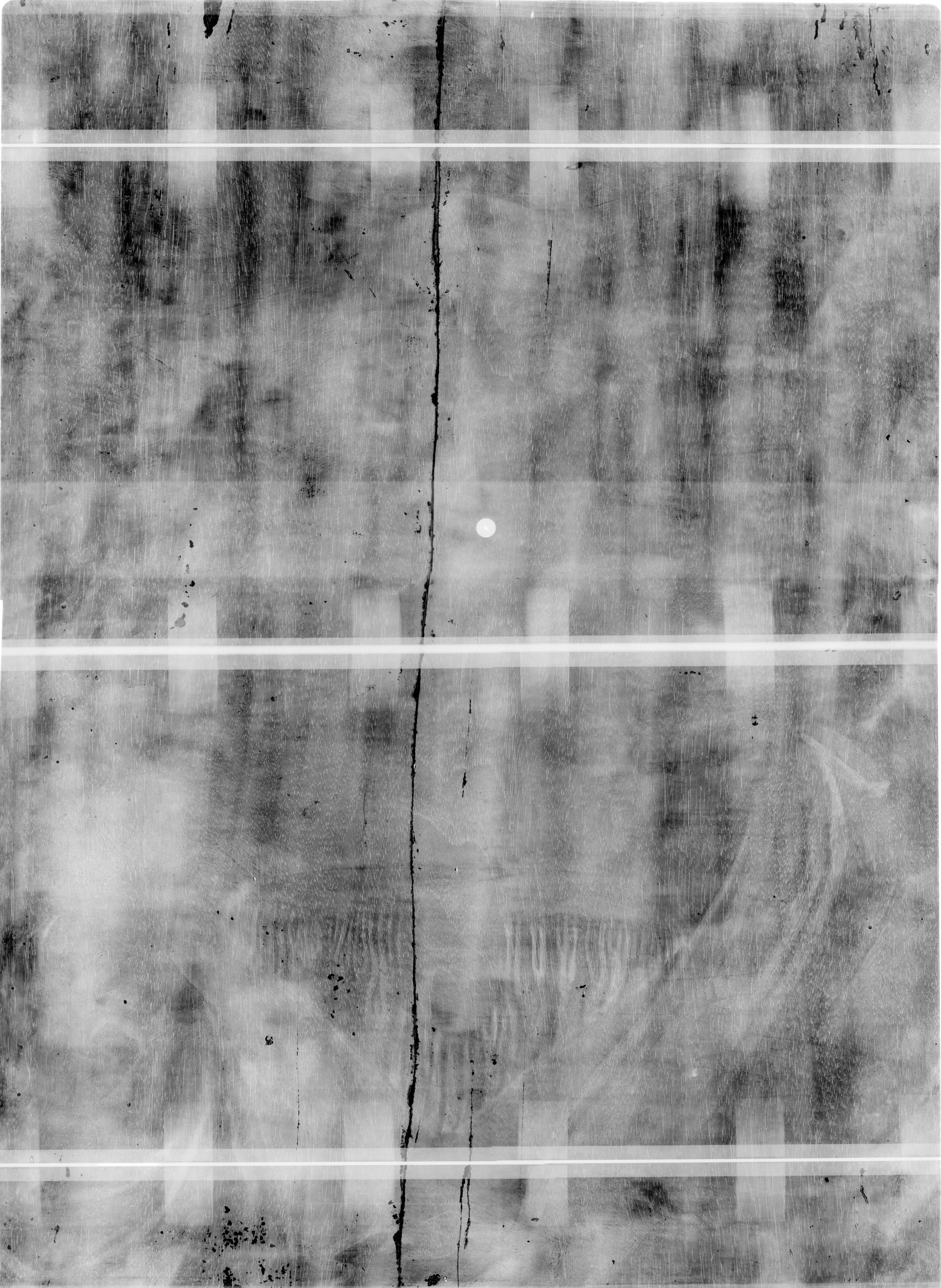 x radiograph
x radiographNow in the Treasury of the Basilica of San Domenico Maggiore, it was originally housed in the chapel of the Muscettola family where it was recorded in 1666, but it is thought to have decorated the earlier, 16th-century chapel of the same family in this church. 48
Like the Cook painting, there is a check in the panel that runs its entire length and transects the head. The ground is primarily lead white, as confirmed by both the x-radiograph and a cross-section.
The infrared reflectogram confirms the use of several cartoons. The dots of spolvero are exceedingly fine and closely spaced. The stole and its knotwork designs appear to have been transferred from a single cartoon and a separate one may have been used for the neckband and pendant with cabochon jewels. Because the dots are so tiny, it is difficult to see them in the IR image at its present resolution. However, while capturing the image spolvero was clearly evident in all of the passages except for the darkened blue mantle and the curls. In fact the latter do not repeat the design of the well-preserved passage of tresses on the proper left. When superimposed over the Salvator Mundi, the composition as a whole doesn’t align perfectly, but if the individual elements are shifted, the face, the blessing hand, the orb, and the stole line up. For the blessing hand, there is a minor difference in the position of the raised fingers, which might reflect the slight shift in the position of that hand, as noted under pentimenti, or may simply be due to a minor mistake made by the copyist when painting the hand. Curiously, the drapery pattern of the proper left shoulder, which cannot be seen in visible light because of the alteration of the azurite pigment, is completely different from both the Ganay copy and the Hollar etching.
The overlay of the hand holding the orb with the same passage in the original shows the fingers placed in the first, higher position that Leonardo used, the pentimento seen in the IR scan, which can also be seen in the cleaned state image. This indicates that the copyist formulated his composition before Leonardo made that adjustment, making a direct connection between the painter and this copy and Leonardo’s studio, before the Salvator Mundi was finished. This and the walnut support point towards one of Leonardo’s assistants in his studio in Milan, Marco d’Oggiono or Salai, making the recent attribution of the painting to Girolamo Alibrandi unlikely. 49
The use by Leonardo’s assistants of partial cartoons, taken from tracings of either original paintings, of drawings, or the original cartoons, to develop independent compostions has been demonstrated, and indeed this was common practice in Renaissance workshops. 50, 51 (A partial cartoon of the infant in the first iteration of that figure in the London Virgin of the Rocks, flipped horizontally and pricked for transfer, was used by Boltraffio for the Esterhàzy Madonna in Budapest. The pinpricks are exceptionally tiny and closely spaced, like the dots of spolvero seen in the IR scan of the Naples copy.)


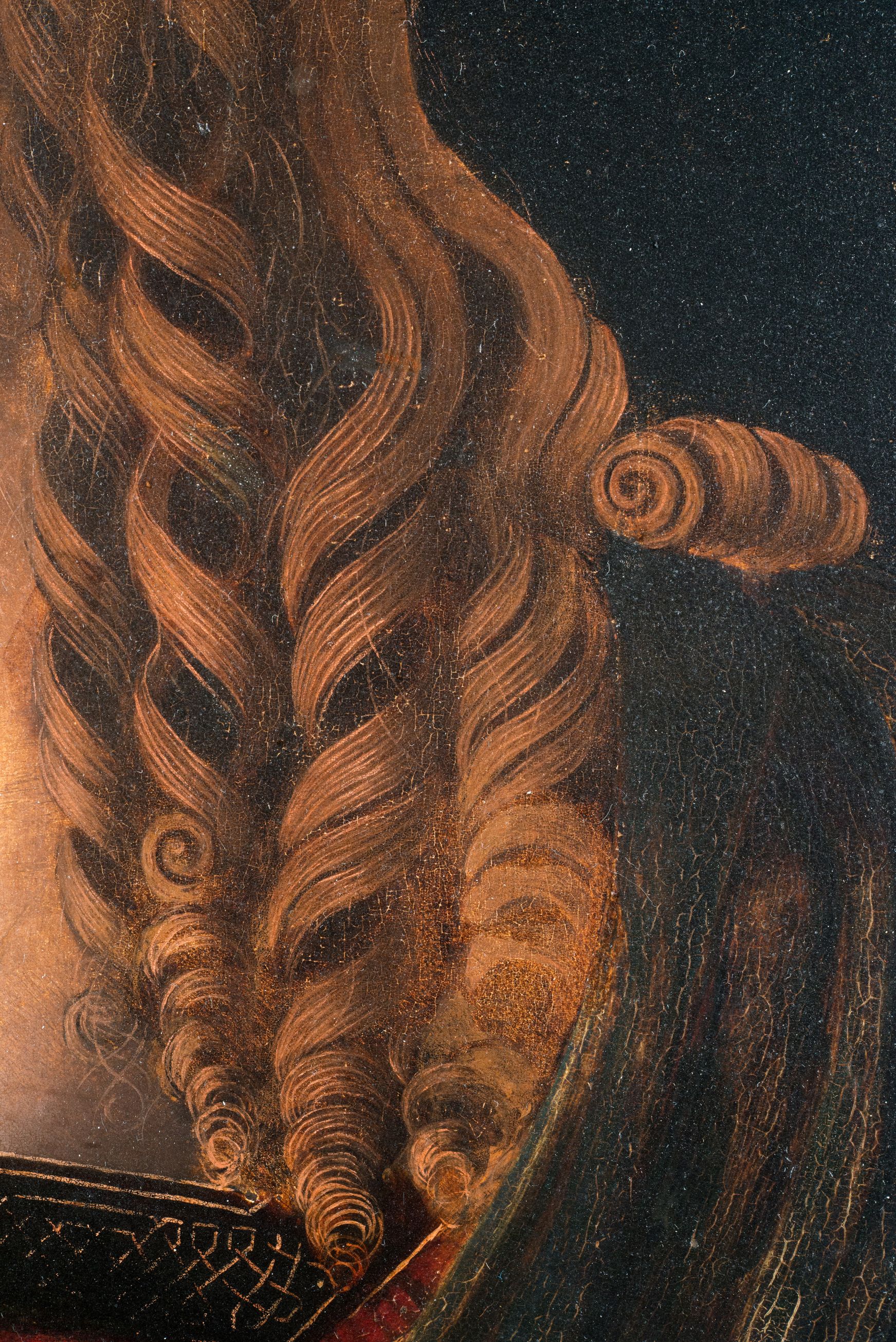
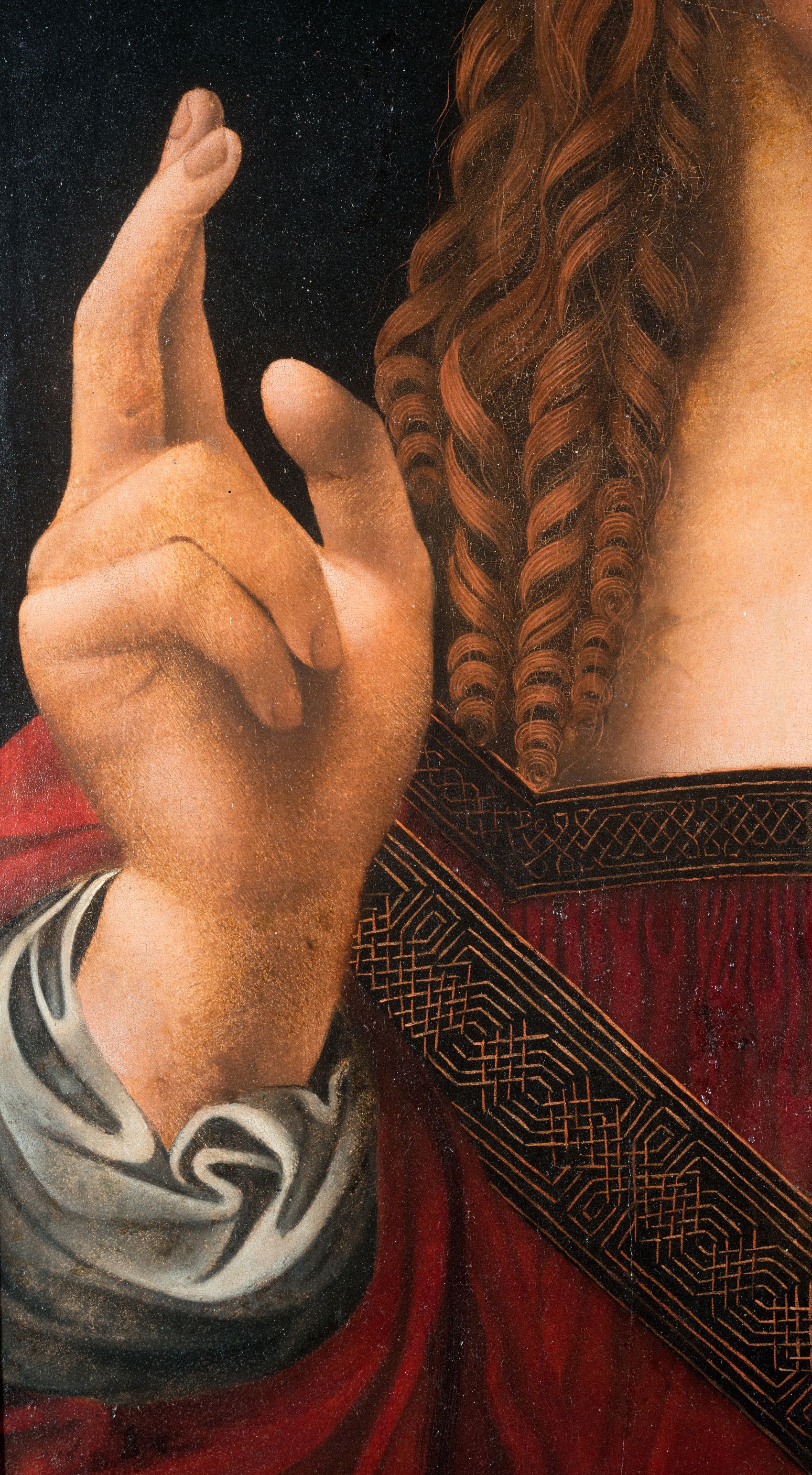
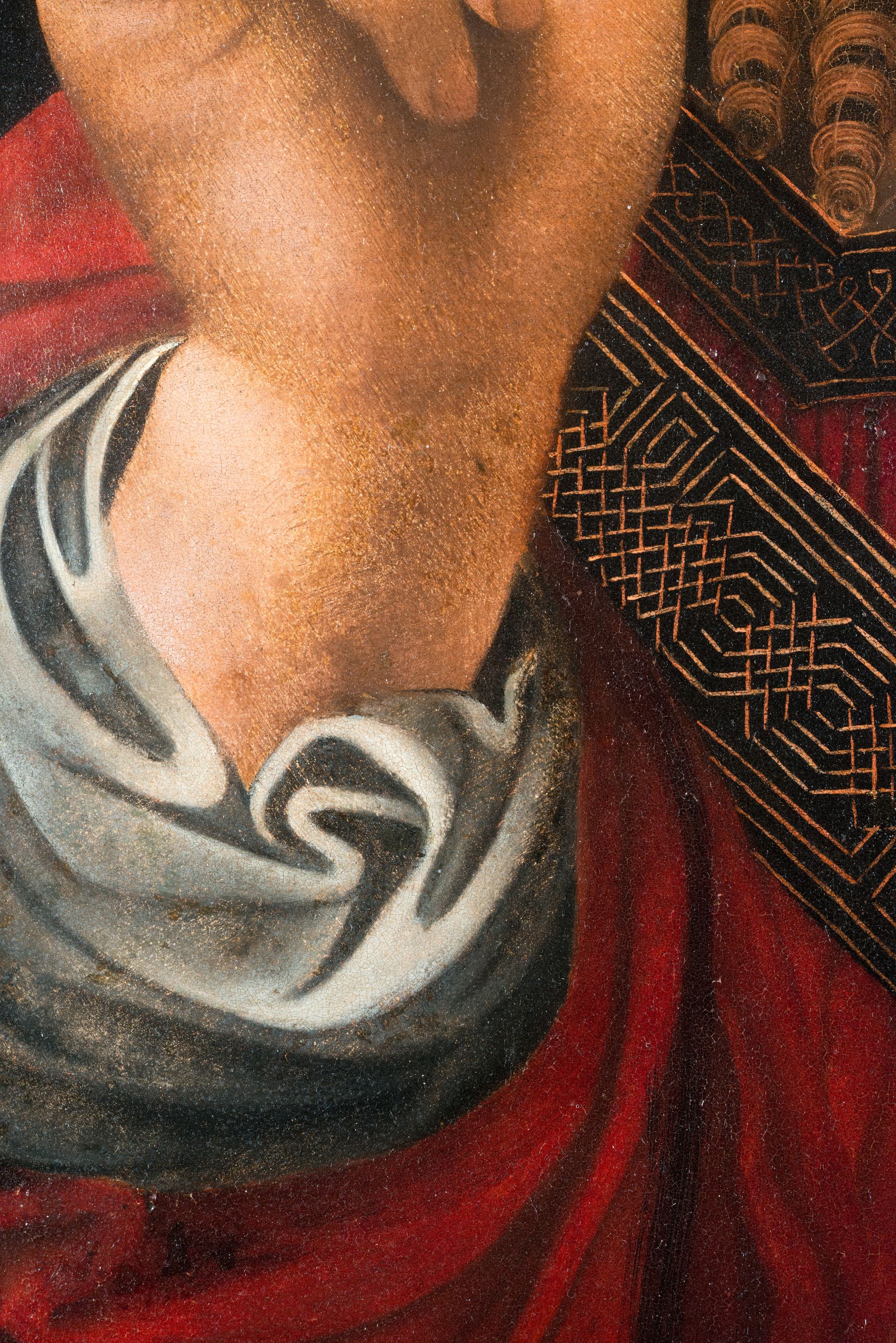
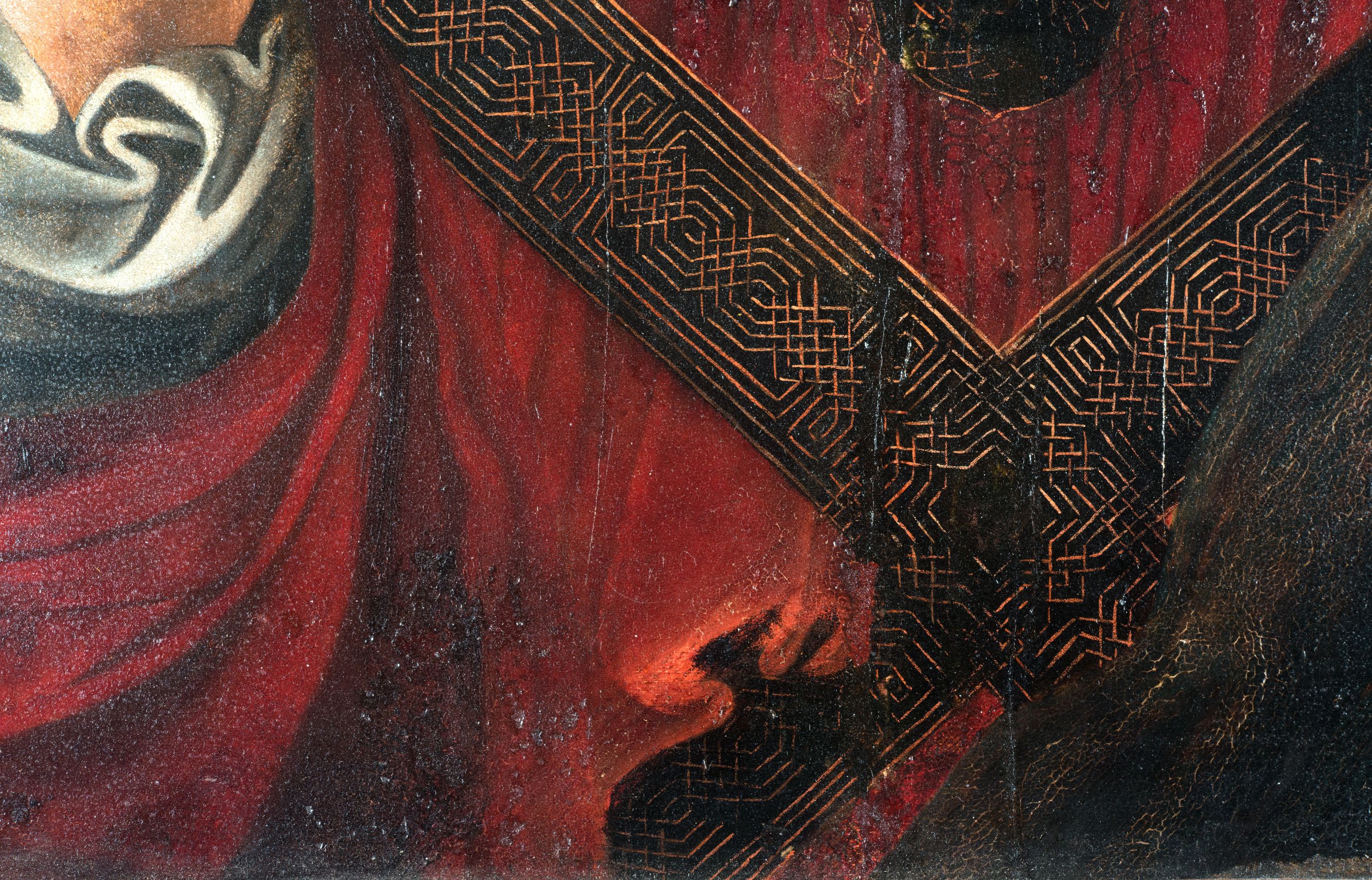
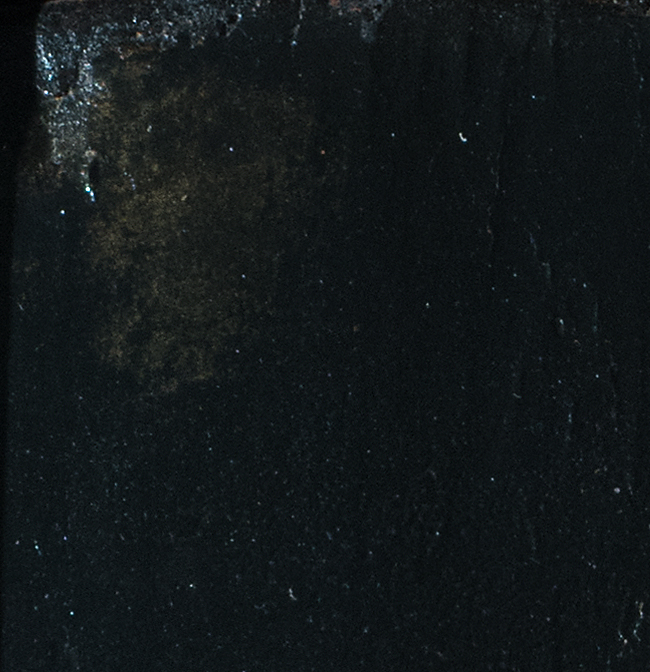
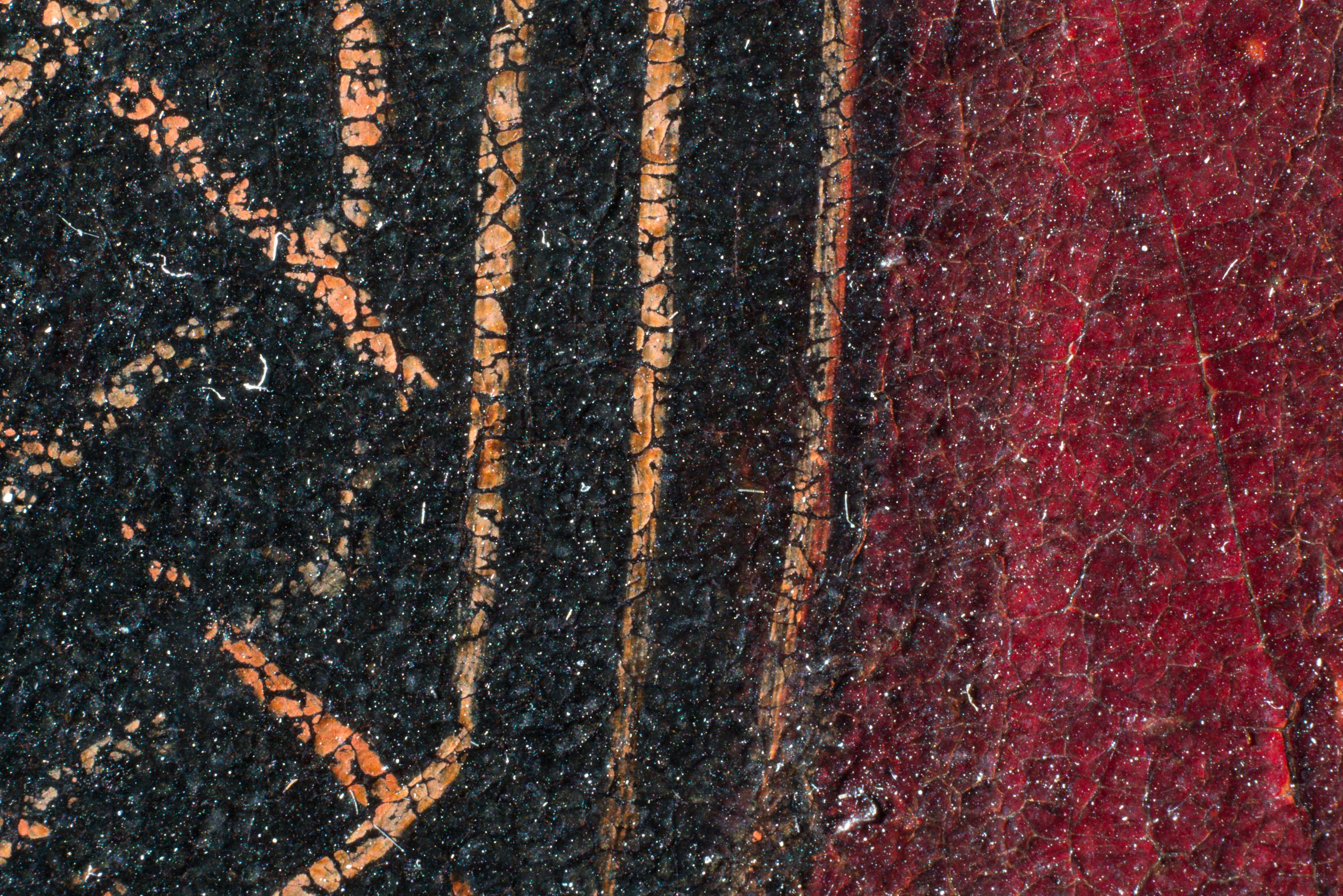
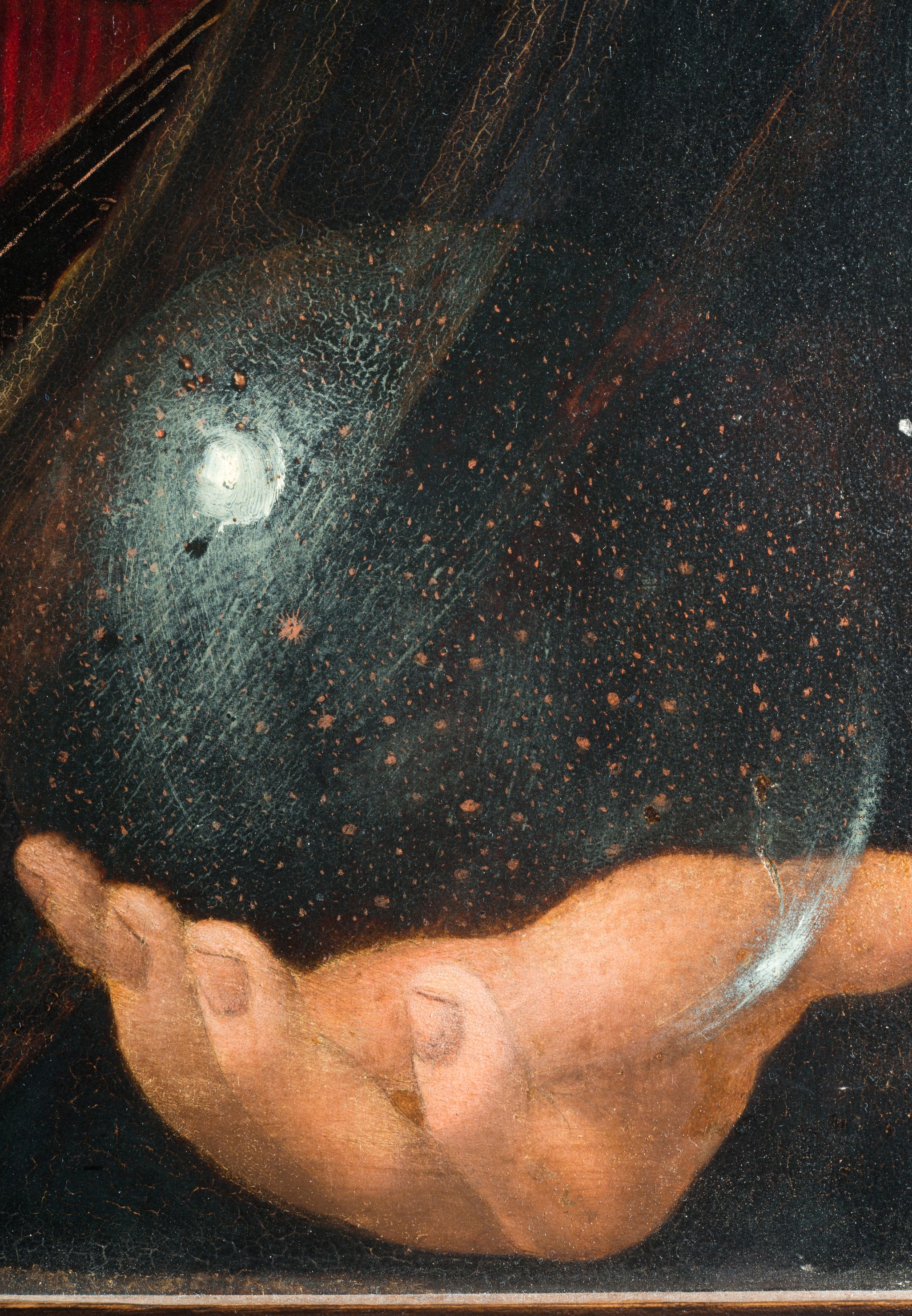
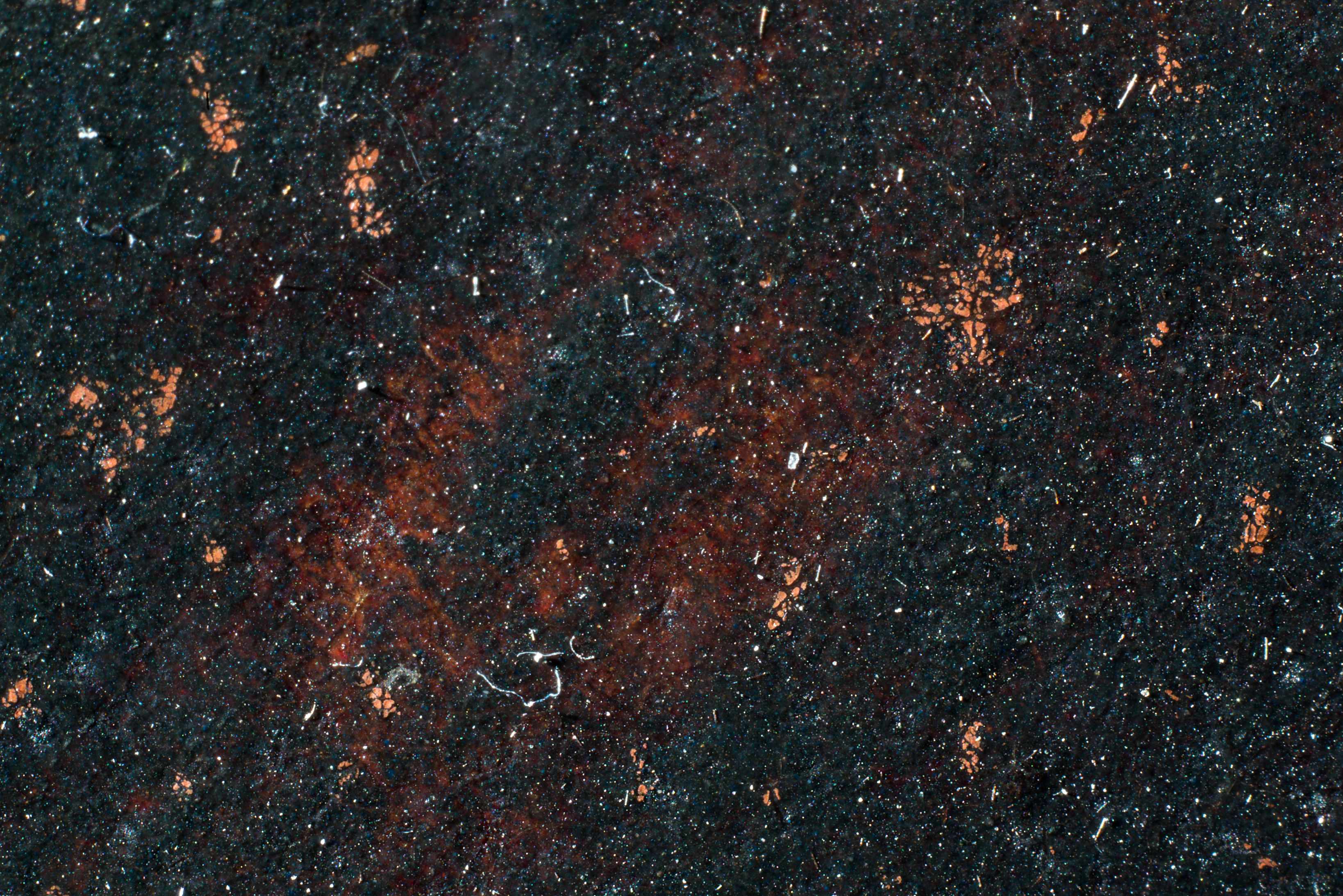
The red drapery is composed of several layers of vermilion of different particle sizes glazed with red lake. The mantle, now darkened, was blue azurite. The orb is painted directly over the blue mantle and has a highlight along the lower right edge, corresponding to the inclusions in that same passage in the original. The pastose white highlight in the upper left may be a later addition, or at least a reinforcement of a similar feature in the original. Tiny dots of yellow paint are spattered across the orb, the largest of which can be seen to be a star.
The knotwork is drawn with simple lines of opaque paint, alternating between reddish-yellow and orangey-red.
The background is black. In the upper left corner a skip reveals the initial lay-in of a translucent black wash.
In both the Naples painting and the Ganay version, the design for the curls on the proper left side of the head are different from those of the ex-Cook painting, suggesting that they had not yet been added when the tracings were taken. In the IR scan, no spolvero are visible. In fact, in Leonardo’s painting, the curls were among the last passages to be painted.
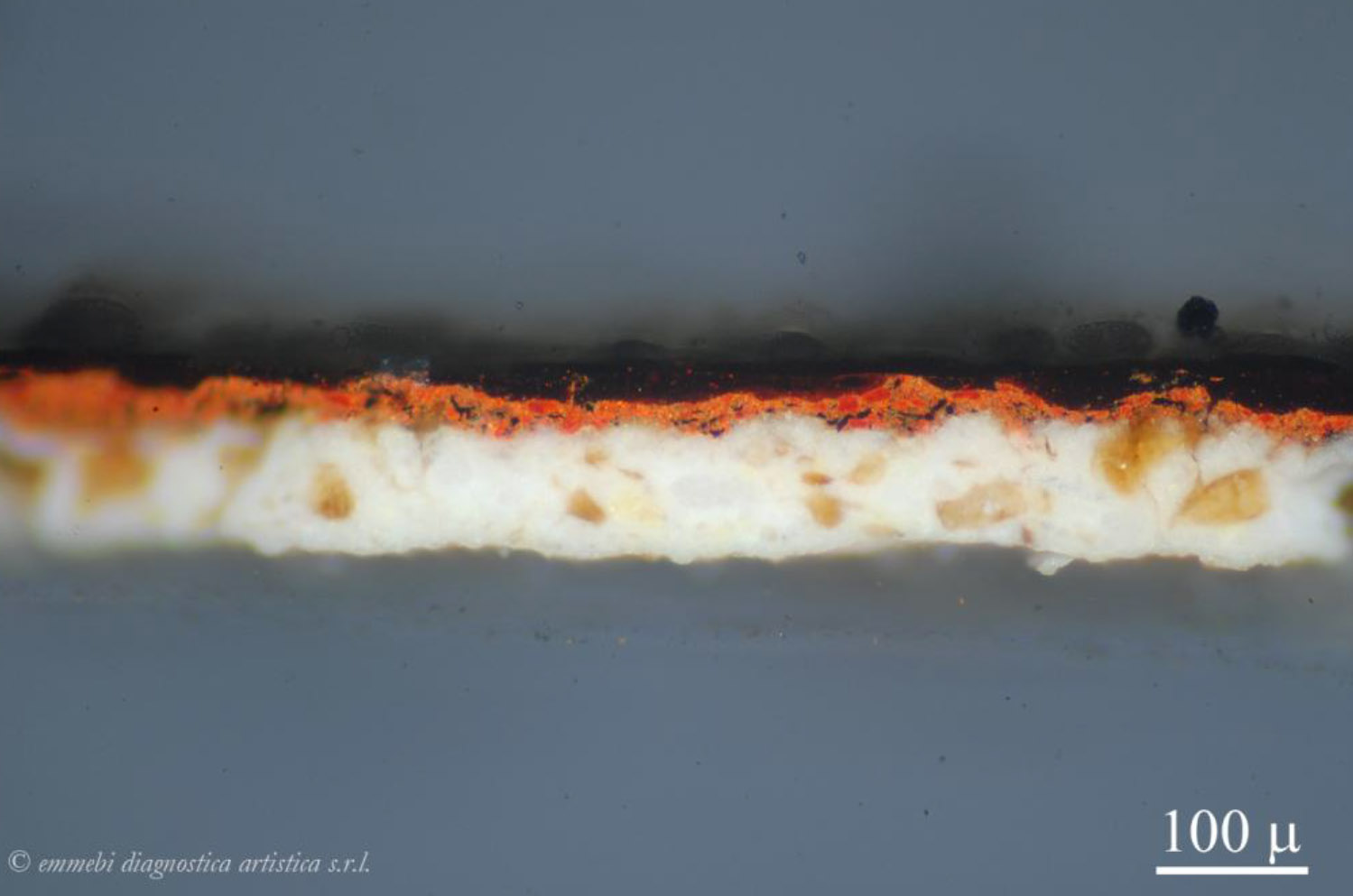
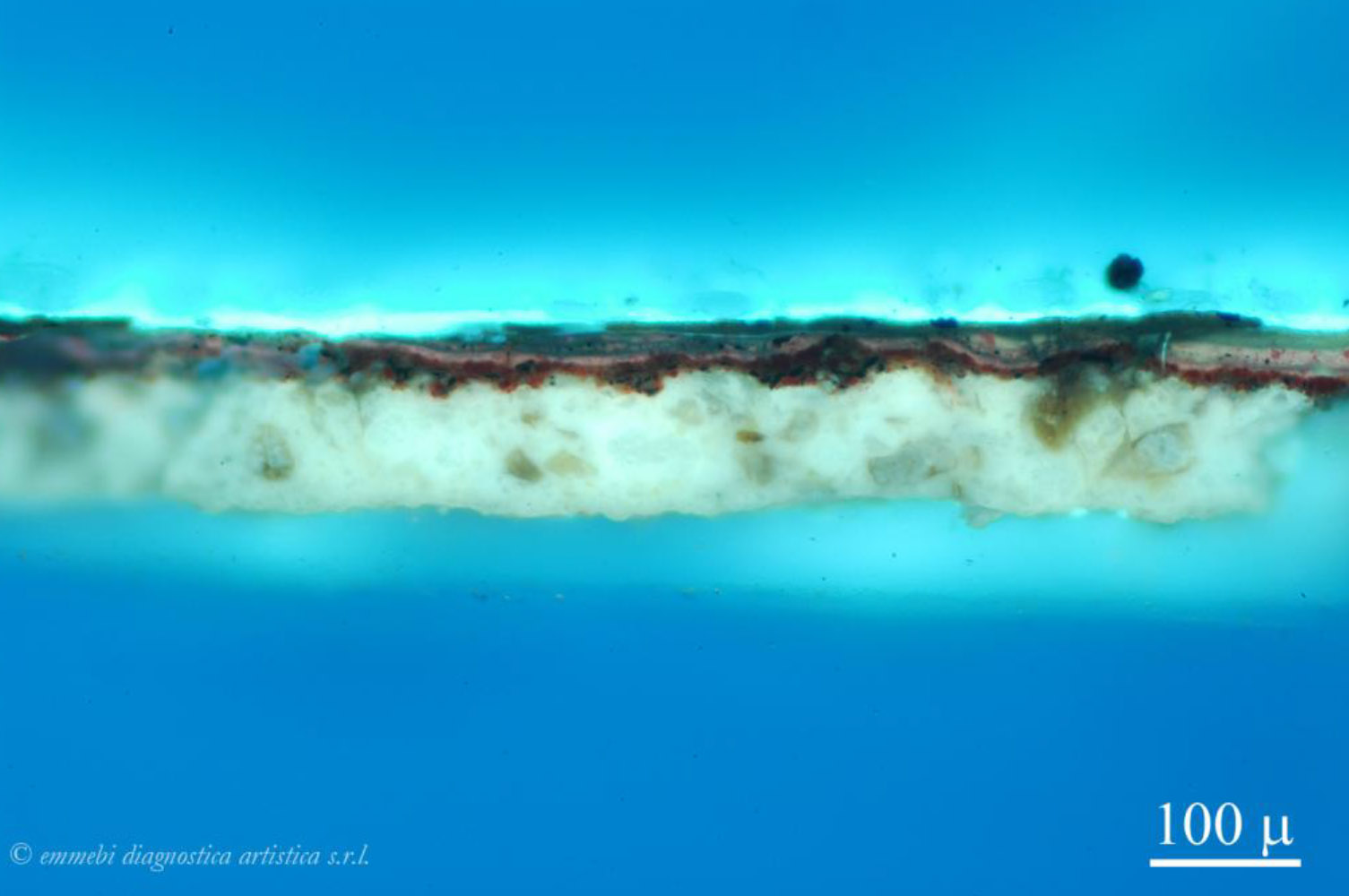
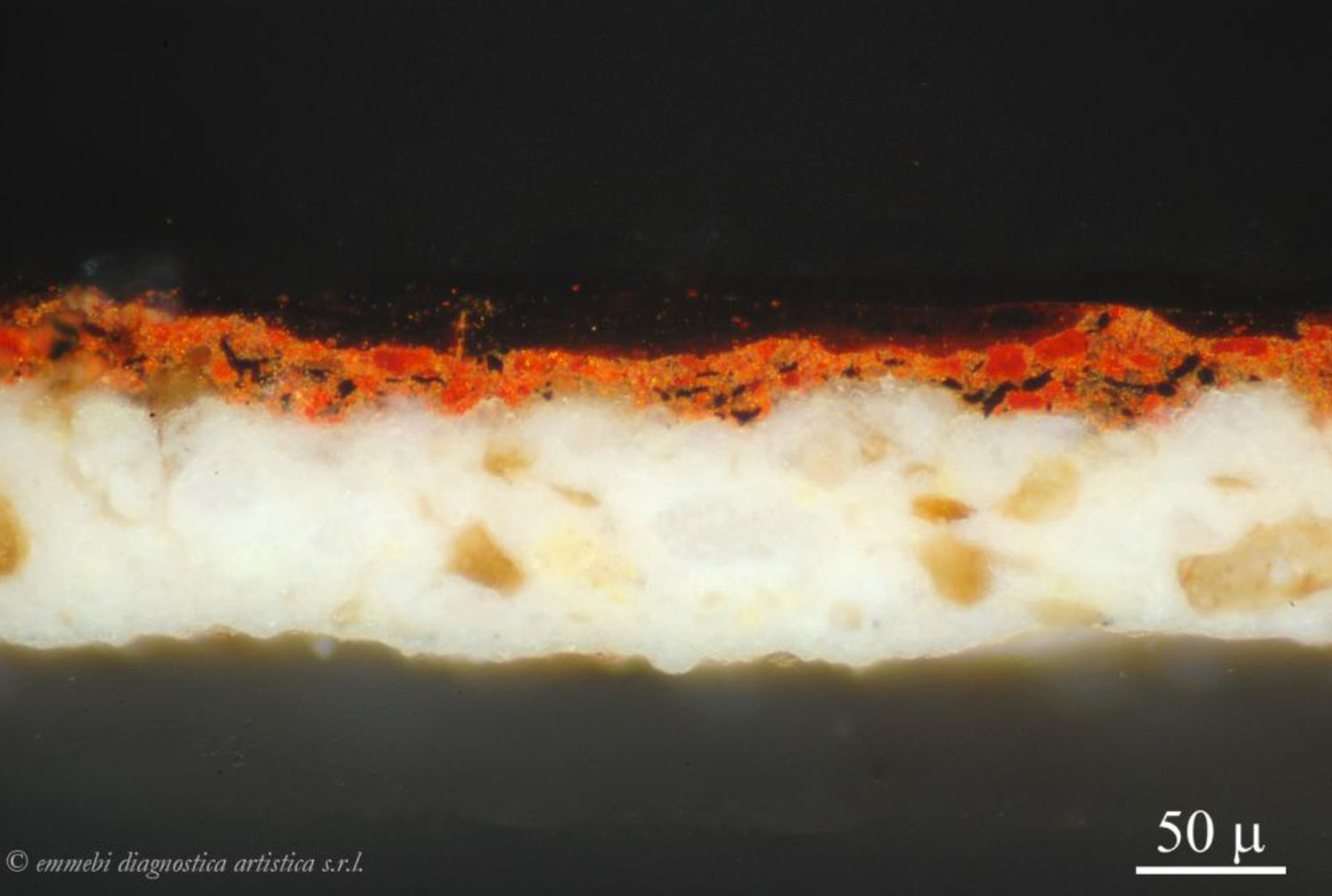
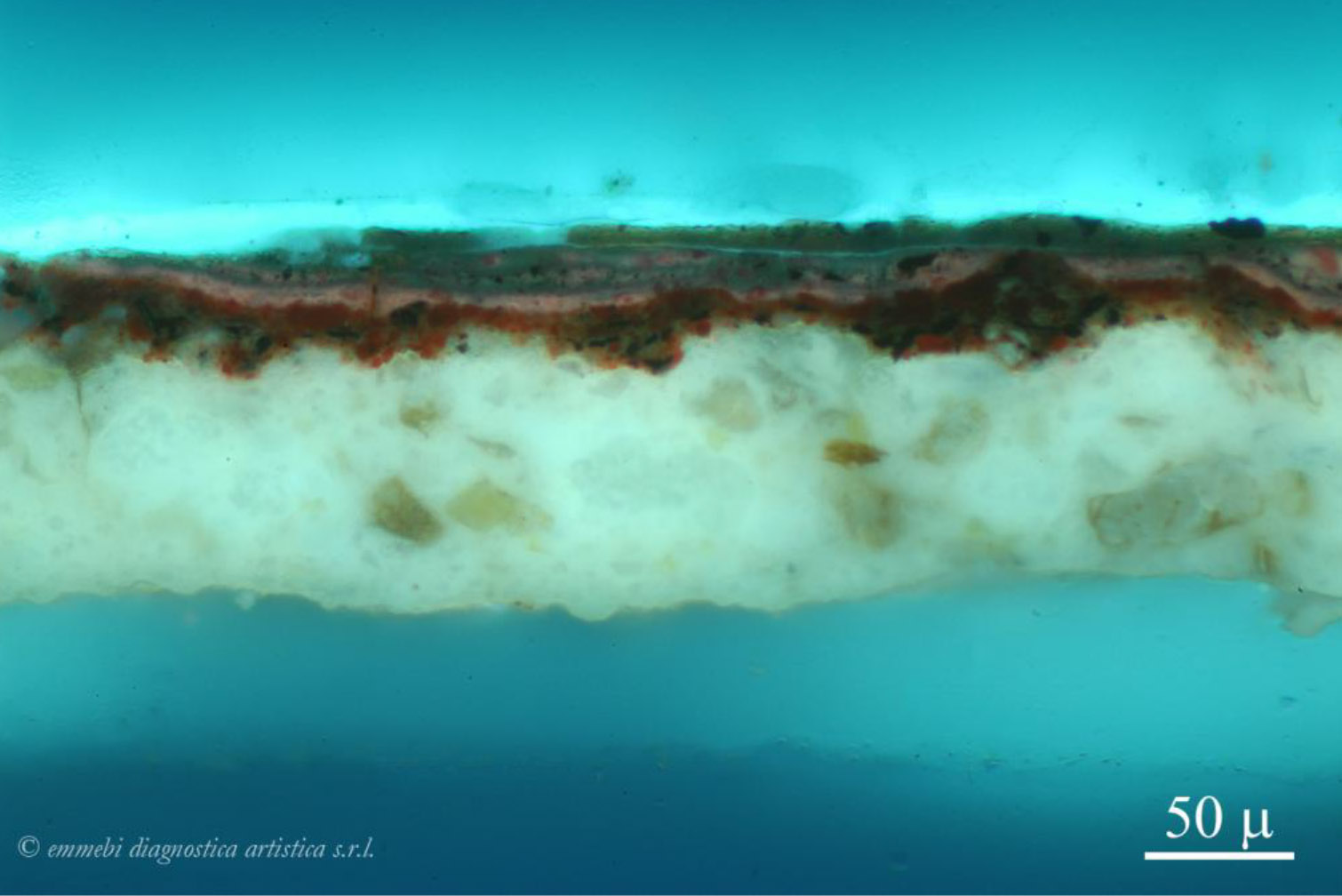
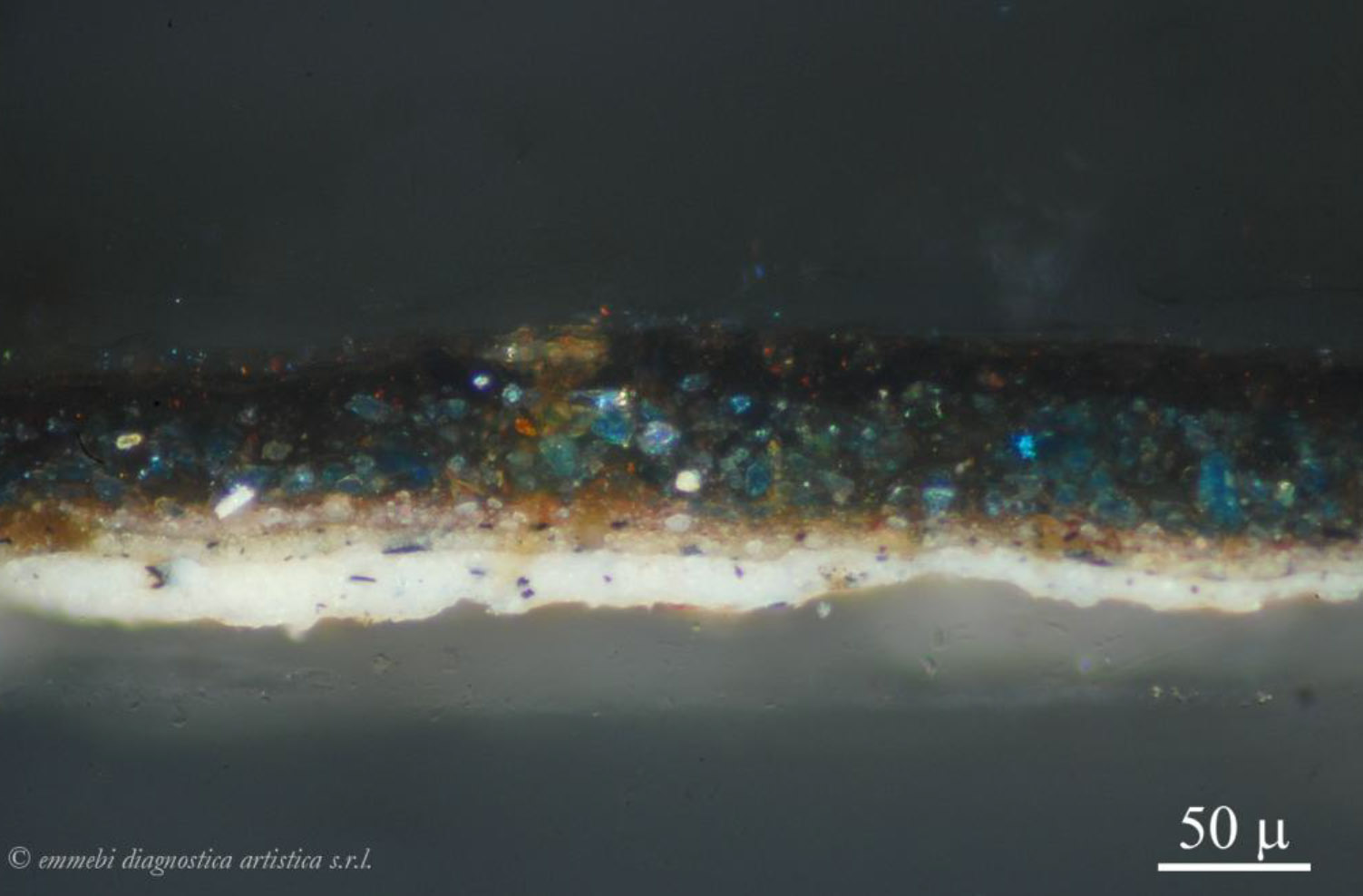
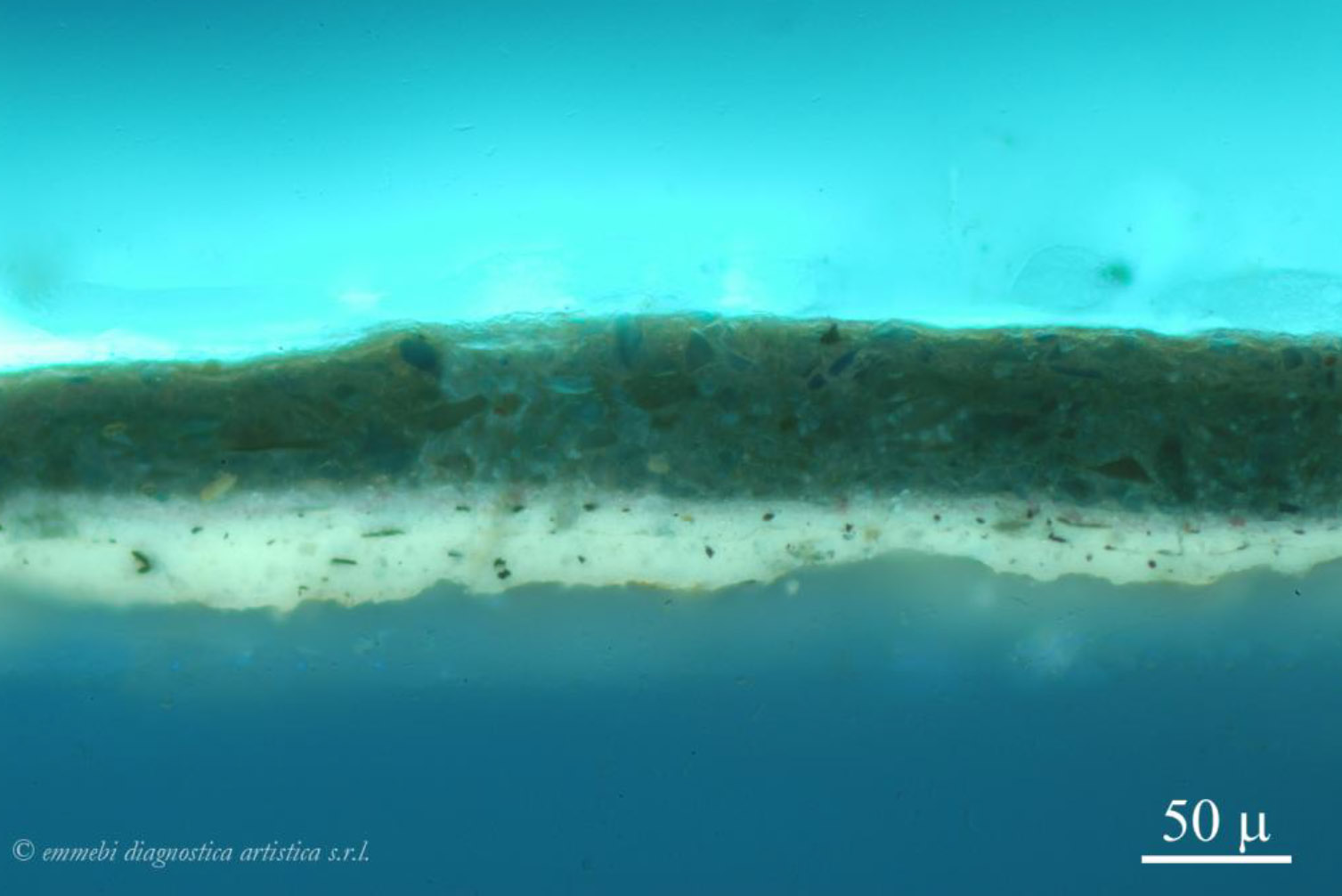
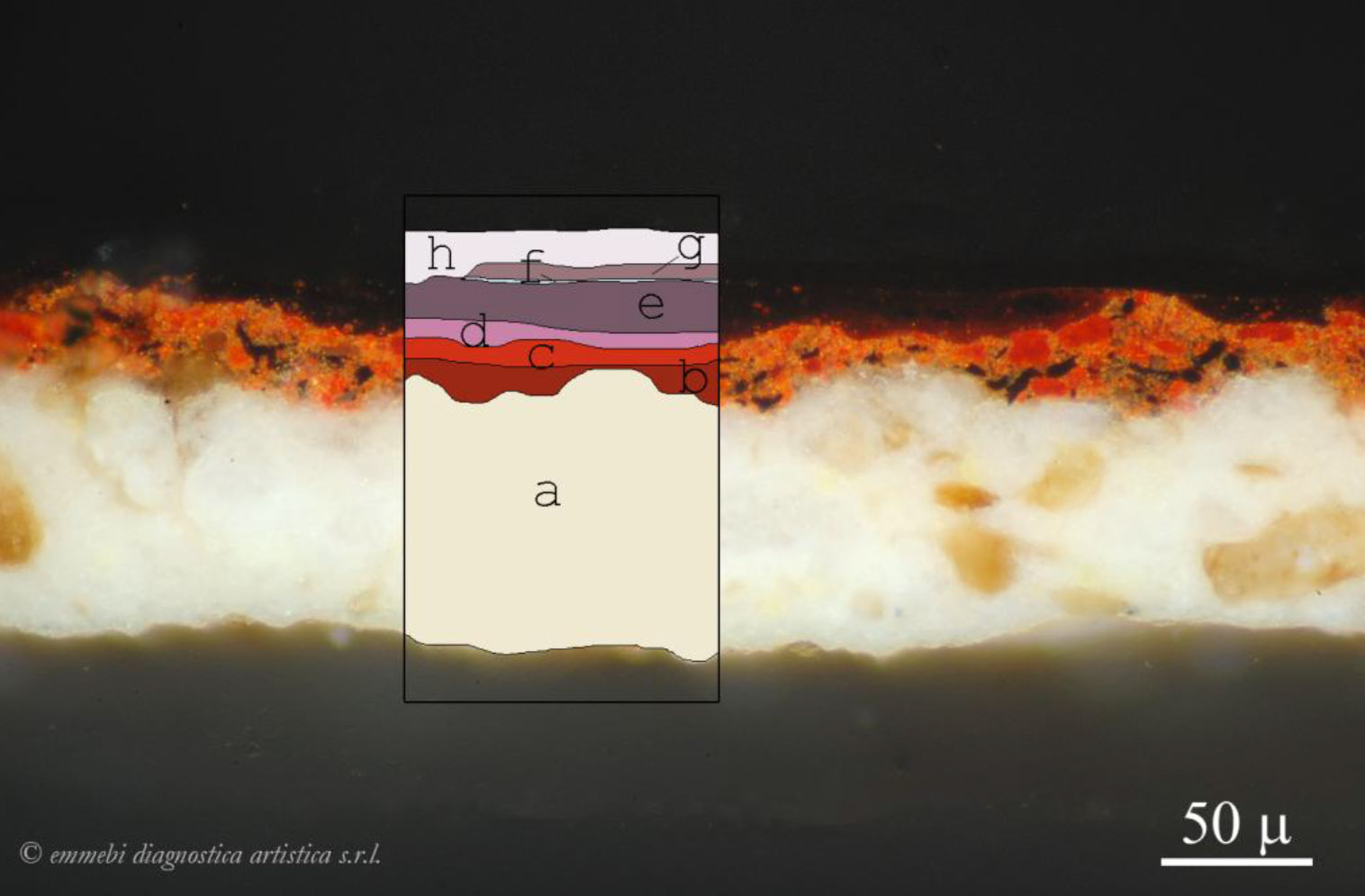

Sample 1 from red drapery:
a. White preparatory layer composed primarily of lead white with tiny particles of another mineral containing zinc and sulphur (zinc sulphate?)
b. Red layer between 5 and 15 microns thick containing cinnabar and tiny brown and black particles, proably carbon. Fluorescent
c. Red layer between 10 and 15 microns thick containing fine and very fine particles of cinnabar and a some aluminum silicates. Little fluorescence
d. Dark reddish brown layer of red lake, moderately fluorescent
e. Dark reddish brown layers containing red lake and some aluminum silicates, moderately fluorescent
f. Thin organic layer, difficult to read, containing red lake No fluorescence
g. Thin dark, organic layer containing particles of lake and and some copper not associated with any particles, possibly a resinous siccative. No fluorescence
h. Translucent organic layer with bright fluorescence. A varnish
Sample 2 from blue drapery:
a. White preparatory layer made up primarily of lead white and containing very fine black particles, probably of an organic nature. Moderately fluorescent
b. White layer, approximately 5 microns thick, made up primarily of lead white and containing very fine black particles, probably of an organic nature. Moderately fluorescent
c. Beige layer made up primarily of lead white, containing primarily lead white and tiny particles of brown and red lake. moderately fluorescent
d. Blue layer, between 30 and 60 microns thick, made up of particles of azurite, with some alteration to a green color and a few very fine particles of quartz red earth. Little fluorescence
e. Dark layer, visible mainly in ultraviolet light, measuring between 30 and 60 microns, containing blue particles of lapis, some iron and lead based particles (pyrite?), and a few particles of azurite. Very little fluorescence
f. Thin layer visible with the electronic microscope
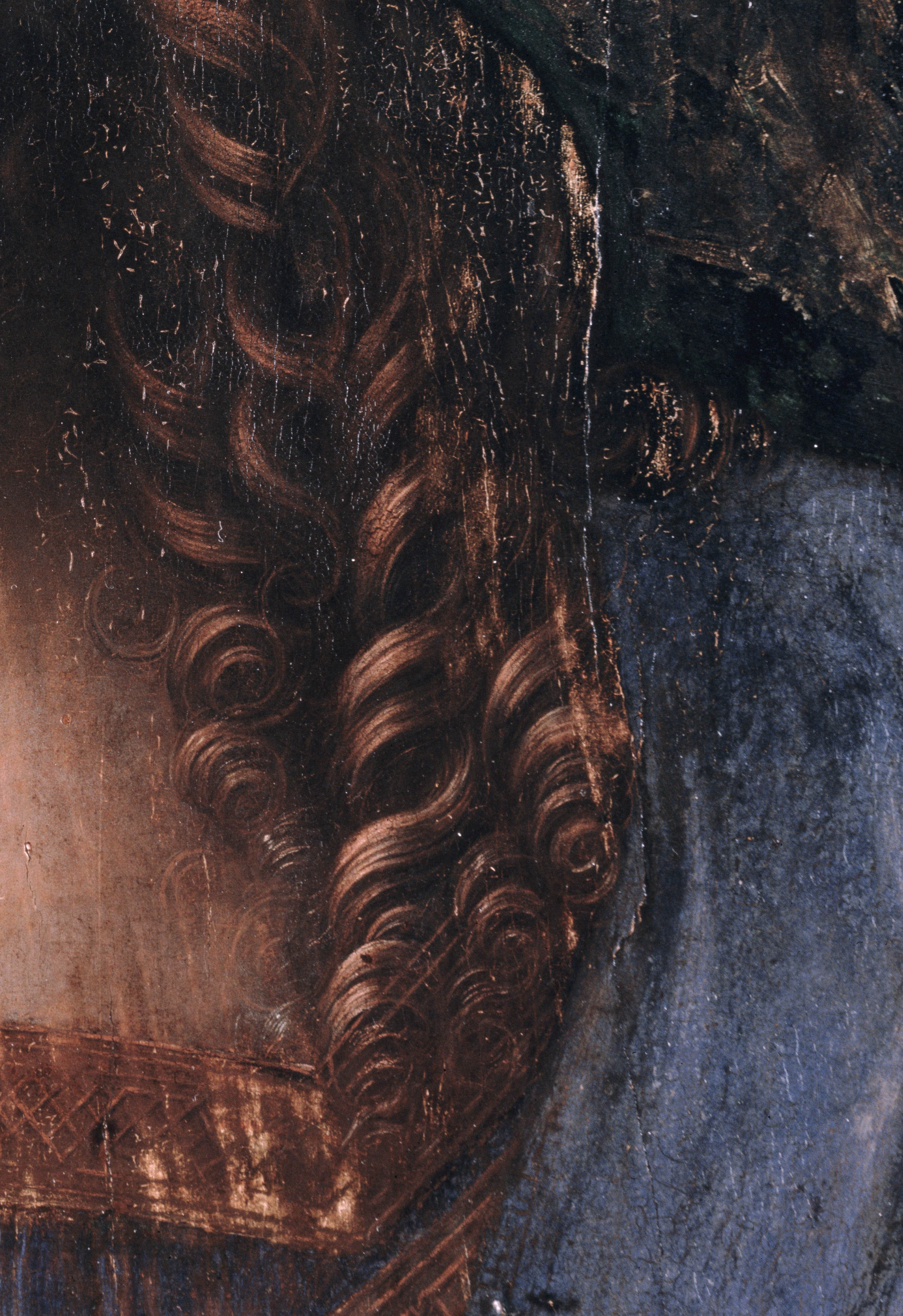
Detail of curls from the Salvator Mundi
 detail of curls from Naples Salvator Mundi
detail of curls from Naples Salvator Mundi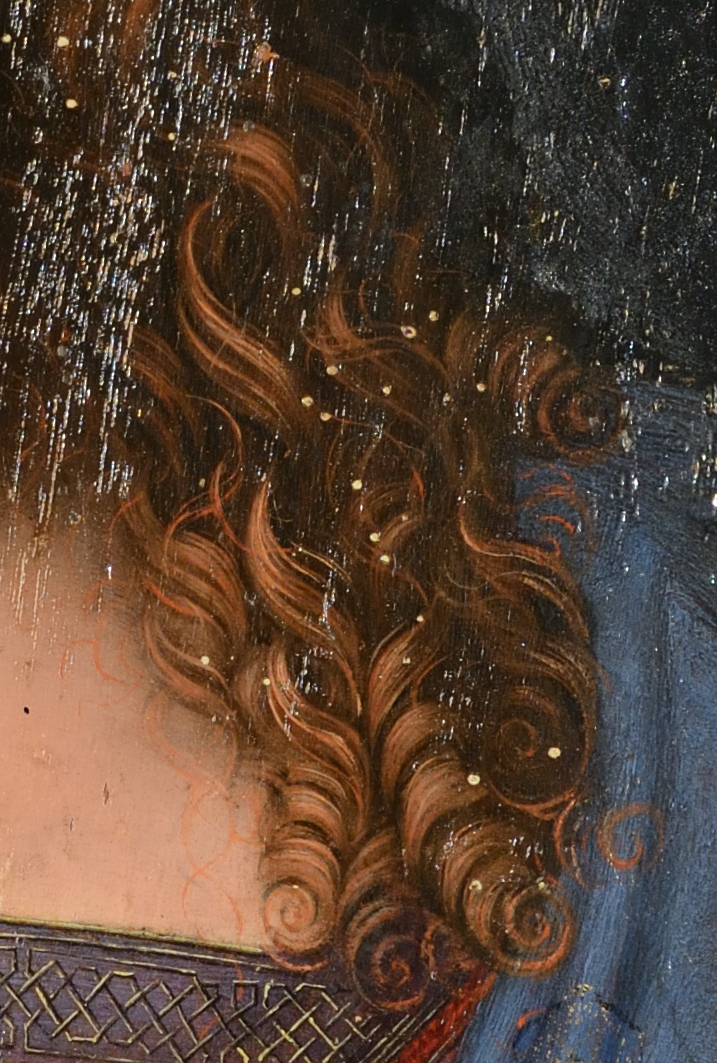













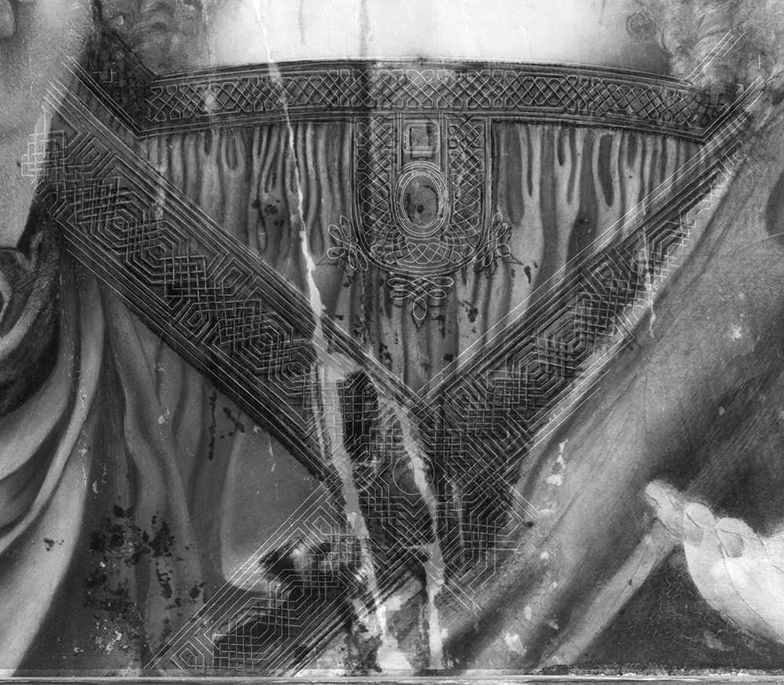
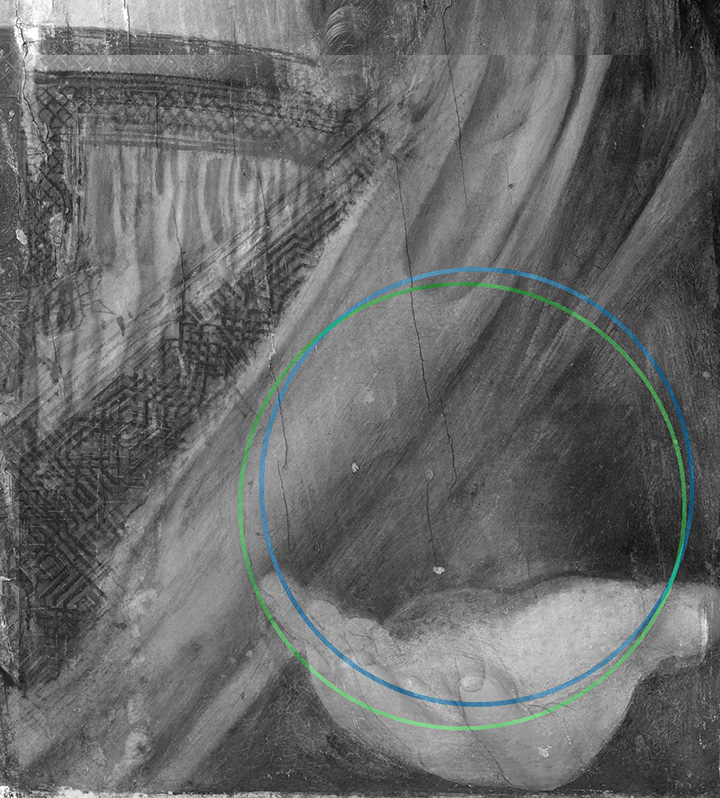
Overlay of IR scans of the Salvator Mundi and the Naples copy
The Hollar etching
It has long been accepted that Leonardo da Vinci’s Salvator Mundi is represented by Wenceslaus Hollar’s 1650 etching. Only three paintings correspond in their details to the etching: Leonardo’s original composition; the Naples version; the ex-Ganay version. Although none of them align with the etching when overlaid, Hollar frequently took license with compositions of paintings it is known he had access to when reproducing them as etchings, as, for example, with his etching of Van Dyck’s double portrait of Lucas and Cornelius de Wael.
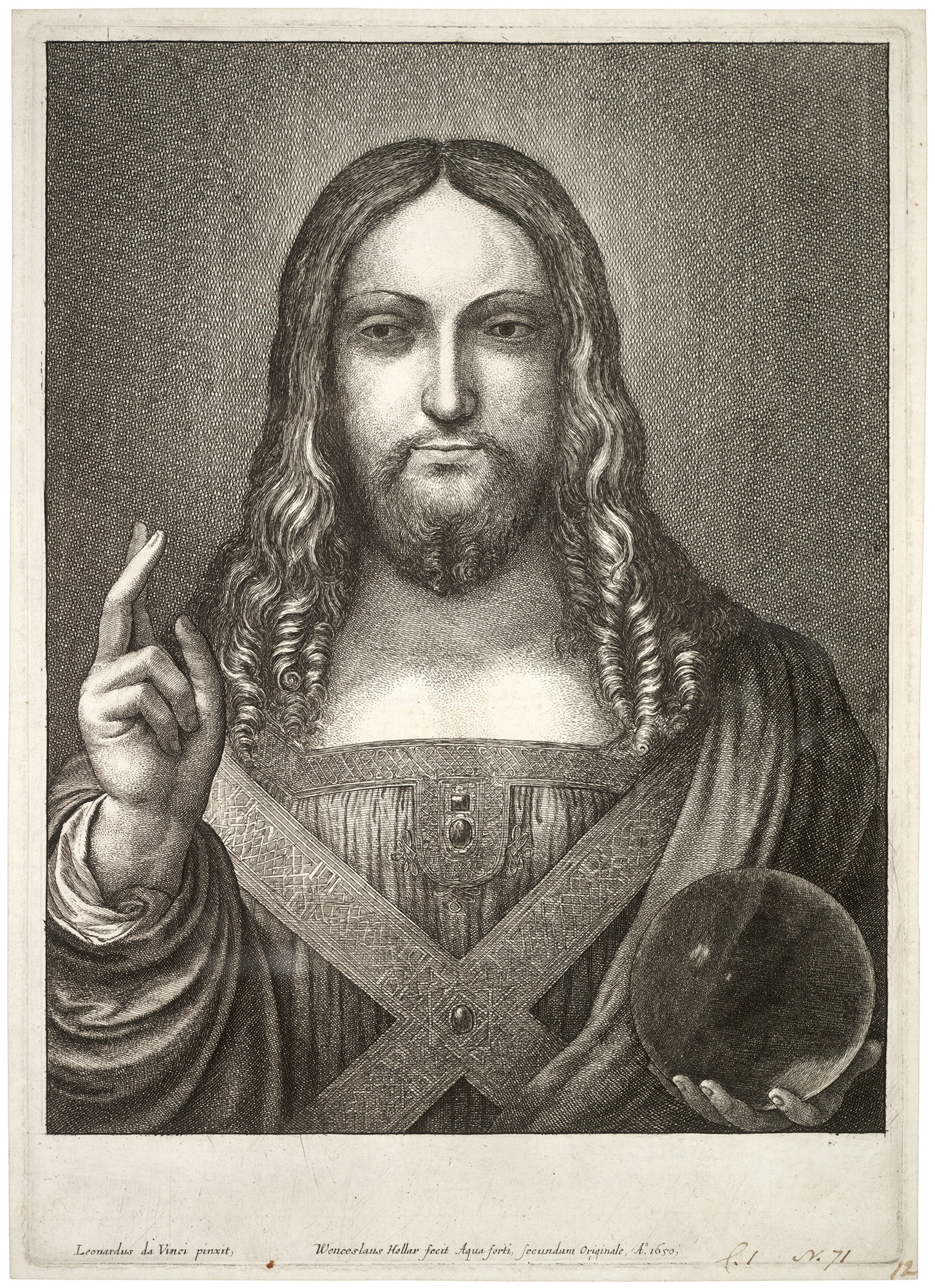
| The Thomas Fisher Rare Book Library, University of Toronto |
Which of the three paintings was copied by Hollar remains an open question, but some observations can be made based on the evidence at hand. The Naples copy can be excluded because it is likely that it was in San Domenico by 1650 and, furthermore, it does not have a moustache or full beard.
The ex-Ganay painting conforms well to the etching. Although, oddly, it lacks the cabochon jewels, it cannot be excluded that it was the model for the Hollar etching. Snow Smith, based on information supplied by the previous owner, suggested that it had been in a convent in Nantes since the sixteenth century. As Maria Teresa Fiorio has pointed out, if this were true it would have been difficult for Hollar to have copied it there, 51 however there is no other proof of this provenance.
On the basis of the characteristics and approximate age of the cradle that was removed during the recent restoration, the Salvator Mundi was almost certainly in England by the early to mid- 19th century before it passed through the hands of Charles Robinson and entered the Cook Collection. Although Christ does not have the nimbus and beard apparent in the etching, the circular shaped damage around the top of the head, as well as the severe abrasion of the original and the remains of old brown repaint in the area of the chin and neck, are not inconsistent with a hypothetical addition of a nimbus and dark beard at an early date. The repainting of the background with verdigris attests to a wholesale recasting of the image in the sixteenth century, which might have included the addition of these elements of the conventional Salvator Mundi iconography. Perhaps the presence of a beard in the Ganay version indicates that the copy was made after this renovation. The androgyny and disquieting nature of Leonardo’s image may have seemed unacceptably heretical to Catholic orthodoxy in France during the religious wars. Certainly, in the copies made of the painting in the later part of sixteenth century, one of which is now known to have been painted in France (the Warsaw version), Christ has a full beard.
The technical evidence is not inconsistent with Margaret Dalivalle’s identification of the ex-Cook painting with one of two paintings attributed to Leonardo in the inventory of the King’s goods drawn up in 1649 after the execution of Charles I. Of these, one is clearly the painting of a Salvator Mundi by Giampietrino in Moscow since it retains Charles I’s collector’s mark on the reverse. According to the inventories, the other painting, “a peece of Christ by Leonard” was returned to the Crown in 1660 after the Restoration. Some of Hollar’s etchings, presumably based on his own earlier drawings, are of paintings that demonstrably belonged to Charles I, Dürer’s 1498 Self Portrait in the Prado being one example. Dalivalle’s argument that the ex-Cook painting is represented in Hollar’s 1650 etching cannot be dismissed out of hand, as many have suggested. It is certain that one of the two painting attributed to Leonardo in the 1649 inventory was restituted to the Royal Collection; that it was alienated and subsequently lost does not prove that it is not the painting cited in the two inventories. It was almost certainly already badly damaged because of the flawed panel support, and repainted. Its poor condition and archaic subject might have made it less than appealing to the Protestant dynasties who succeeded James II.
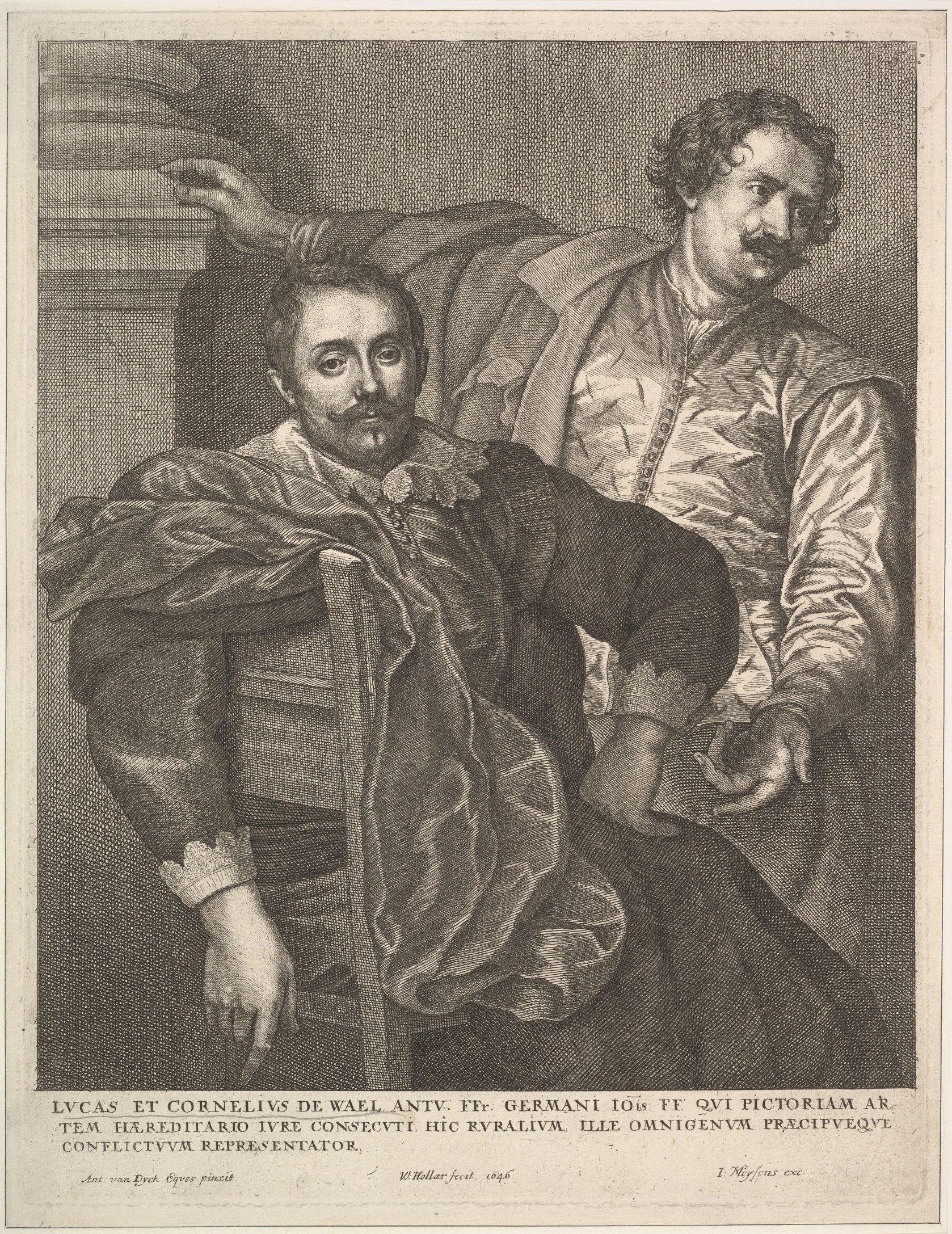
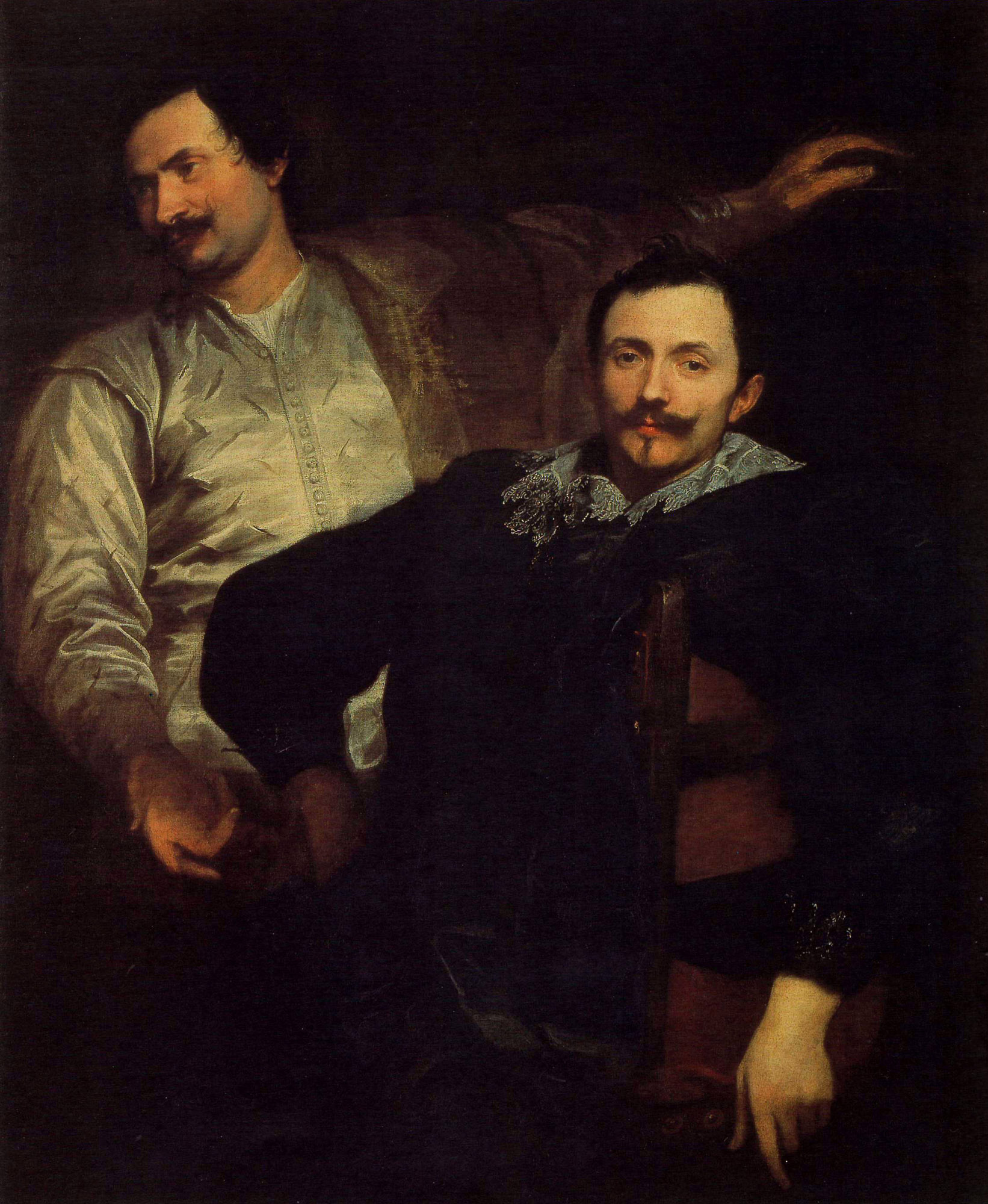
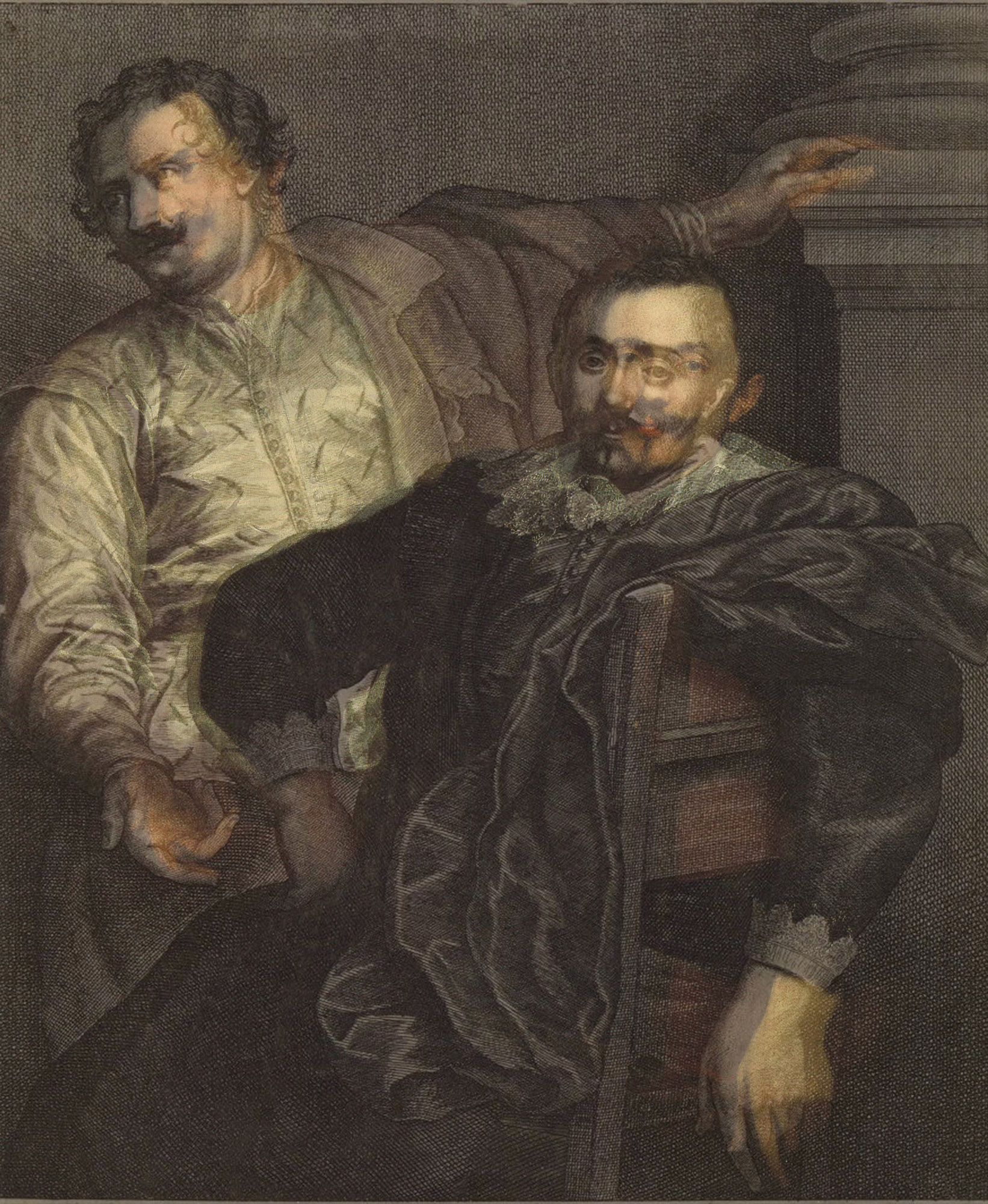
Wikimedia Common
